Sales Analysis#
Number of Sales#
pb.configure(
df = df_sales
, time_column = 'order_purchase_dt'
, time_column_label = 'Date'
, metric = 'order_id'
, metric_label = 'Share of Sales'
, metric_label_for_distribution = 'Number of Sales'
, agg_func = 'nunique'
, norm_by='all'
, axis_sort_order='descending'
, text_auto='.1%'
, update_fig={'xaxis': {'tickformat': '.0%'}}
)
print(f'Total number of sales: {df_sales.order_id.nunique()}')
Total number of sales: 96346
Let’s see at statistics and distribution of the metric.
pb.metric_info(freq='D')
| Summary | Percentiles | Detailed Stats | Value Counts | |||||||
|---|---|---|---|---|---|---|---|---|---|---|
| Total | 602 (100%) | Max | 1.15k | Mean | 160.04 | 140 | 10 (2%) | |||
| Missing | --- | 99% | 362.98 | Trimmed Mean (10%) | 155.10 | 149 | 7 (1%) | |||
| Distinct | 255 (42%) | 95% | 293 | Mode | 140 | 72 | 7 (1%) | |||
| Non-Duplicate | 90 (15%) | 75% | 214.75 | Range | 1143 | 103 | 7 (1%) | |||
| Duplicates | 347 (58%) | 50% | 148.50 | IQR | 114.50 | 66 | 6 (<1%) | |||
| Dup. Values | 165 (27%) | 25% | 100.25 | Std | 88.83 | 138 | 6 (<1%) | |||
| Zeros | --- | 5% | 45 | MAD | 82.28 | 252 | 6 (<1%) | |||
| Negative | --- | 1% | 10.01 | Kurt | 24.43 | 188 | 6 (<1%) | |||
| Memory Usage | <1 Mb | Min | 4 | Skew | 2.57 | 145 | 6 (<1%) | |||

Key Observations:
75% of days had ≤215 orders
5% had ≤45 orders
5% had ≥293 orders
Several days exceeded 400 orders
Let’s look by different dimensions.
By Season
Since 2018 has incomplete monthly data, it’s better to also analyze by year…
pb.bar_groupby(
x='purchase_season'
, color='purchase_year'
)
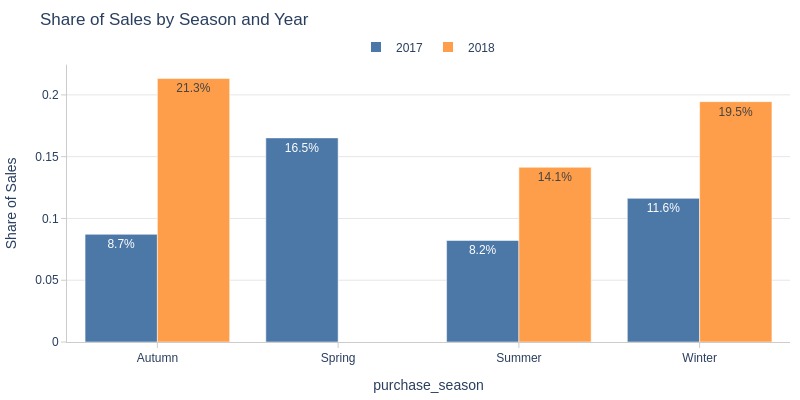
Key Observations:
Lowest sales in summer (both years)
Highest sales in autumn (2018)
By Time of Day
pb.bar_groupby(y='purchase_time_of_day')
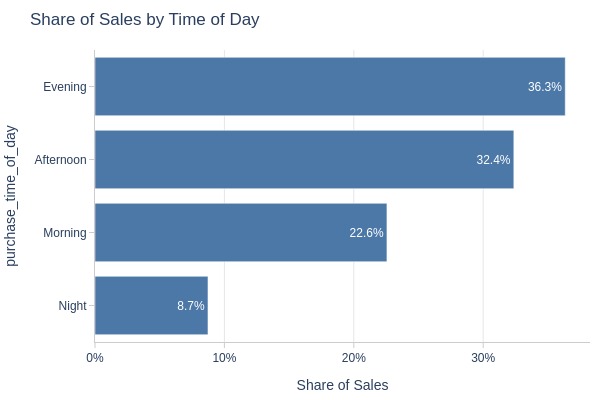
Key Observations:
Sales by time of day:
Evening: 36% (peak)
Night: 9% (lowest)
Morning: 23%
Afternoon: 32%
By Day of Week
pb.bar_groupby(y='purchase_weekday')
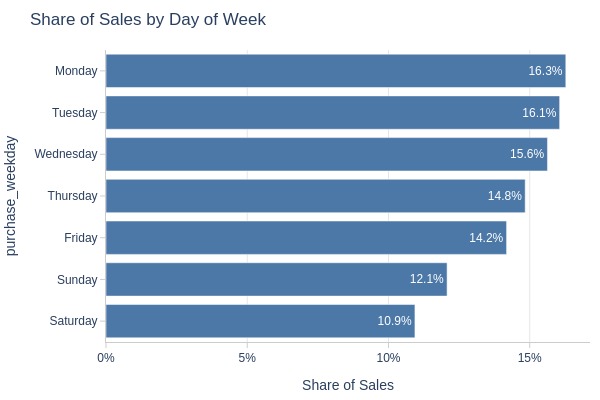
Key Observations:
Saturday: 11% (lowest)
Monday: 16% (highest)
By Weekday vs Weekend
pb.bar_groupby(y='purchase_day_type')
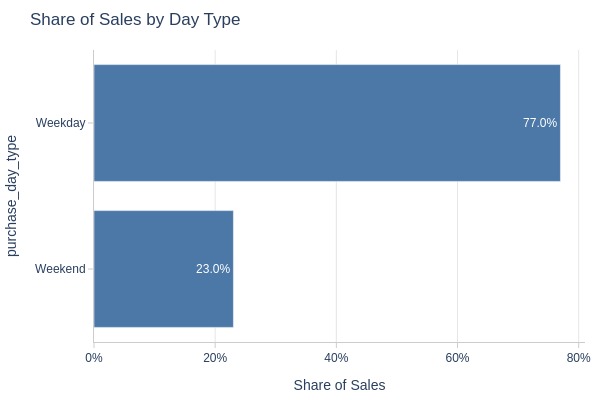
Key Observations:
77% of orders were placed on weekdays
By Day of the Week and Hour of the Day
fig = pb.heatmap(
x='purchase_hour'
, y='purchase_weekday'
, labels={'color': 'Number of Sales'}
, title='Number of Sales by Day of the Week and Hour of the Day'
).update_layout(xaxis_dtick=1, xaxis_tickformat=None)
pb.to_slide(fig)
fig.show()
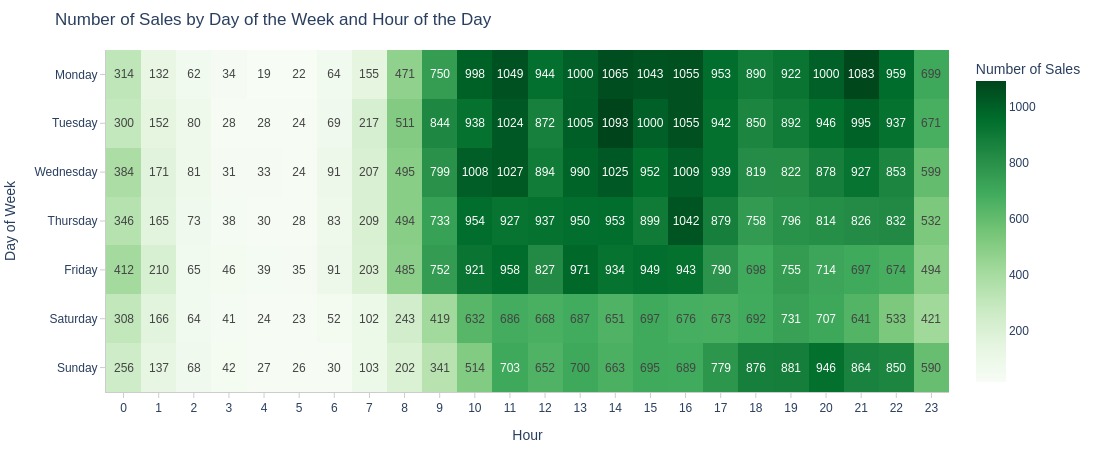
Key Observations:
1AM-8AM had lowest sales across all weekdays
By Review Score
pb.bar_groupby(y='order_avg_reviews_score')
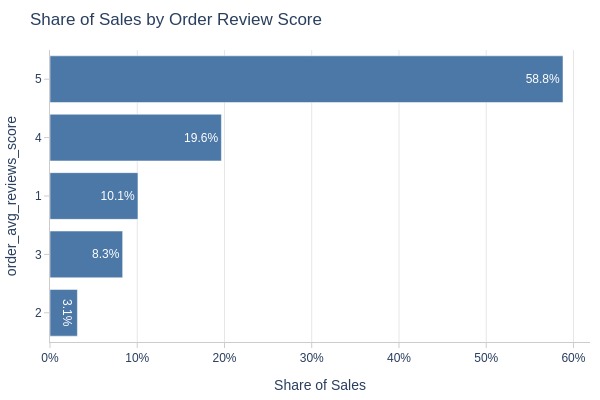
Key Observations:
Review score distribution:
5 stars: 59%
2 stars: 3% (lowest)
More 1-star than 2/3-star orders
By Whether the Order is Delayed or Not
pb.bar_groupby(y='is_delayed')
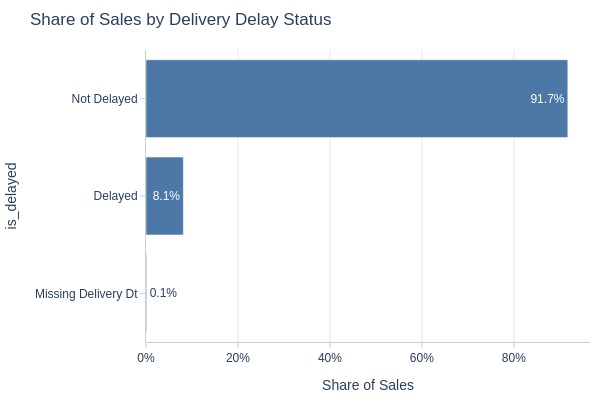
Key Observations:
92% of orders had no delivery delay
By Payment Category
pb.bar_groupby(y='order_total_payment_cat')
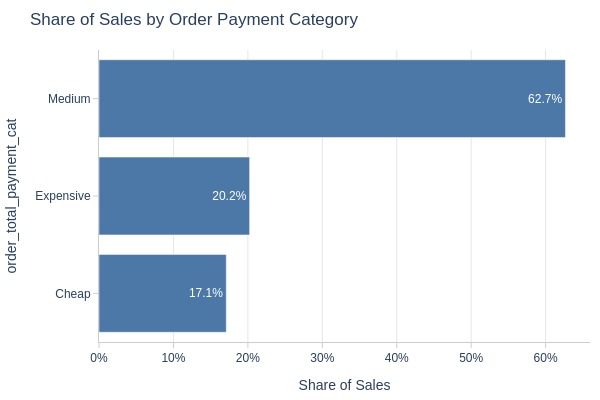
Key Observations:
63% of orders were medium-priced
By Order Weight Category
pb.bar_groupby(y='order_total_weight_cat')
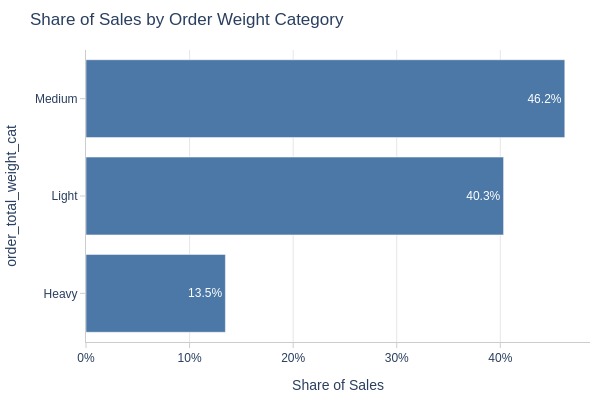
Key Observations:
Order weight distribution:
Medium: 46%
Light: 40%
By Delivery Time Category
pb.bar_groupby(y='delivery_time_days_cat')
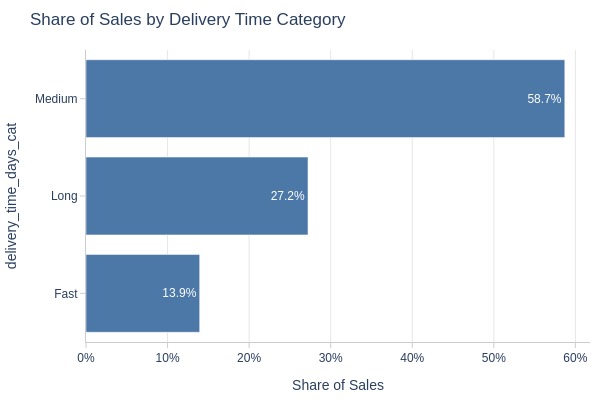
Key Observations:
59% of orders had medium delivery time
By Presence of Installment Payments
pb.bar_groupby(y='order_has_installment')
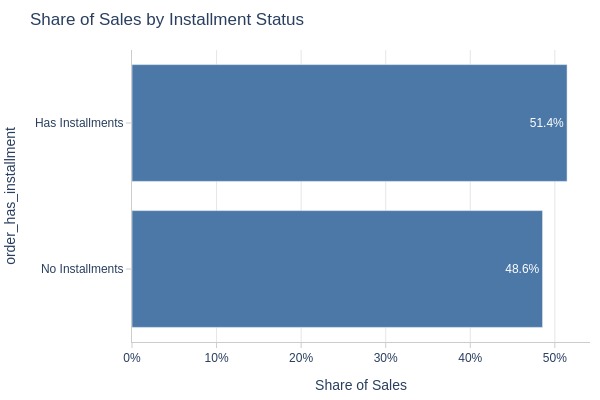
Key Observations:
51% of orders used installments
By Payment Type
pb.bar_groupby(y='order_payment_types')
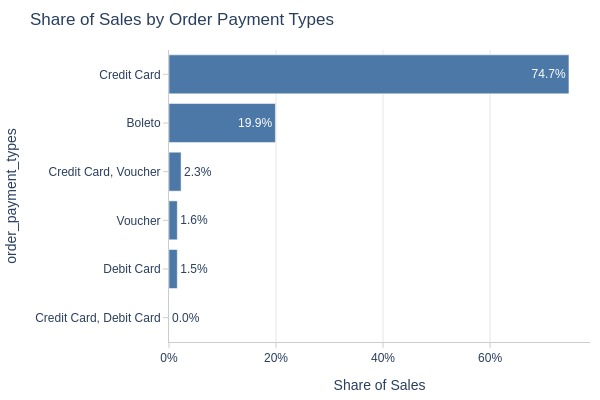
Key Observations:
Payment methods:
Credit card: 75%
Boleto: 20%
By Product Category
pb.bar_groupby(
y='order_product_categories'
, text_auto=False
)

Key Observations:
Top 3 product categories:
Bed Bath Table: 9%
Health Beauty: 9%
Sports Leisure: 8%
By Generalized Product Category
pb.bar_groupby(
y='order_general_product_categories'
, text_auto=False
)
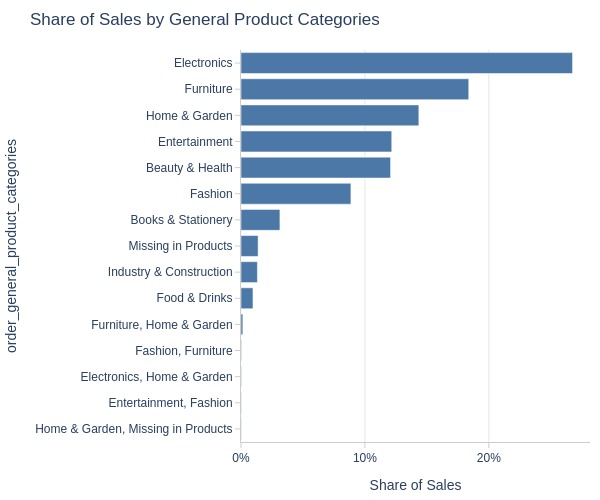
Key Observations:
Top 3 generalized categories:
Electronics: 27%
Furniture: 18%
Home & Garden: 14%
By Top Customer States
pb.bar_groupby(y='customer_state', text_auto=False)
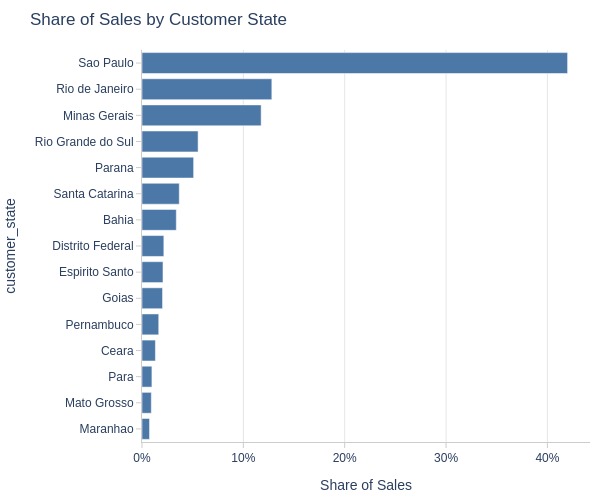
Key Observations:
Sales by state:
São Paulo: 42%
Rio de Janeiro: 13%
Minas Gerais: 12%
Others: ≤6%
By Top Customer Cities
pb.bar_groupby(y='customer_city', text_auto=False)
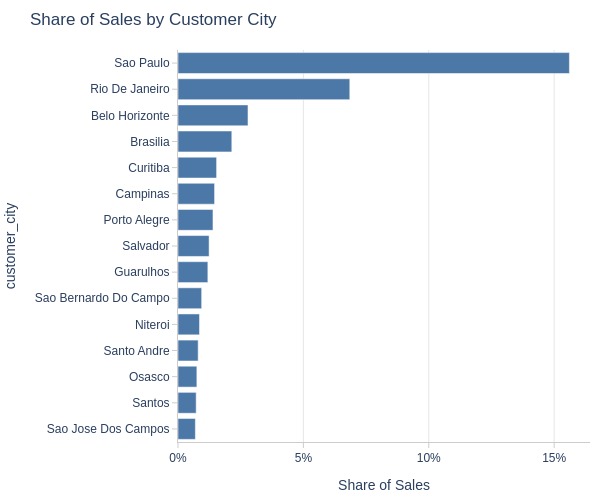
Key Observations:
Sales by city:
São Paulo: 16%
Rio de Janeiro: 7%
Others: ≤3%
Sum of Sales#
pb.configure(
df = df_sales
, time_column = 'order_purchase_dt'
, metric = 'total_payment'
, metric_label = 'Sum of Sales, R$'
, agg_func = 'sum'
, title_base = 'Sum and Number of Sales'
, axis_sort_order='descending'
, text_auto='.3s'
, update_fig={'xaxis2': {'title_text': 'Number of Sales'}}
)
print(f'Total Sales Amount: {df_sales.total_payment.sum():,.2f}, R$')
Total Sales Amount: 15,399,404.87, R$
Let’s see at statistics and distribution of the metric.
pb.metric_info(freq='D')
| Summary | Percentiles | Detailed Stats | Value Counts | |||||||
|---|---|---|---|---|---|---|---|---|---|---|
| Total | 602 (100%) | Max | 175.25k | Mean | 25.58k | 707.27 | 1 (<1%) | |||
| Missing | --- | 99% | 57.35k | Trimmed Mean (10%) | 24.72k | 27687.48 | 1 (<1%) | |||
| Distinct | 602 (100%) | 95% | 48.90k | Mode | Multiple | 39162.30 | 1 (<1%) | |||
| Non-Duplicate | 602 (100%) | 75% | 33.76k | Range | 174.74k | 35845.39 | 1 (<1%) | |||
| Duplicates | --- | 50% | 23.46k | IQR | 18.59k | 31531.31 | 1 (<1%) | |||
| Dup. Values | --- | 25% | 15.17k | Std | 14.28k | 34643.87 | 1 (<1%) | |||
| Zeros | --- | 5% | 6.73k | MAD | 13.47k | 24342.08 | 1 (<1%) | |||
| Negative | --- | 1% | 1.57k | Kurt | 19.15 | 25377.01 | 1 (<1%) | |||
| Memory Usage | <1 Mb | Min | 507.85 | Skew | 2.22 | 27569.29 | 1 (<1%) | |||
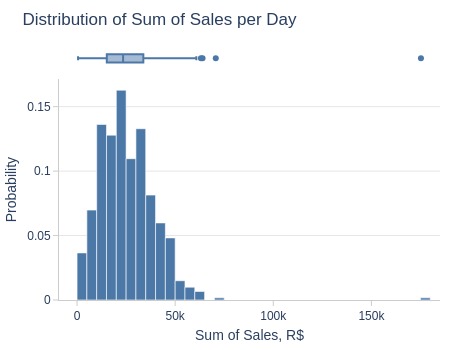
Key Observations:
75% of days had sales ≤33K R$
5% of days had ≤6.7K R$
5% of days had ≥49K R$
Several days exceeded 70K R$
Let’s look by different dimensions.
By Season
Since 2018 has incomplete monthly data, it’s better to also analyze by year…
pb.bar_groupby(
x='purchase_season'
, color='purchase_year'
, title='Sum of Sales by Season and Year'
)
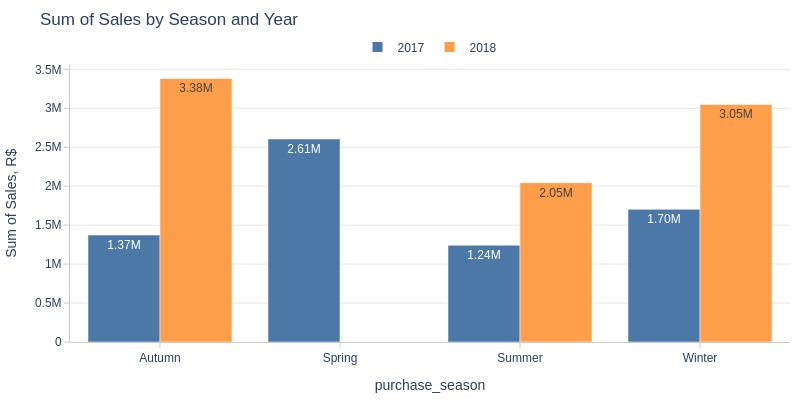
Key Observations:
Lowest sales revenue in summer (both years)
Highest revenue in autumn (2018)
By Time of Day
pb.bar_groupby(y='purchase_time_of_day', show_count=True, to_slide=True)
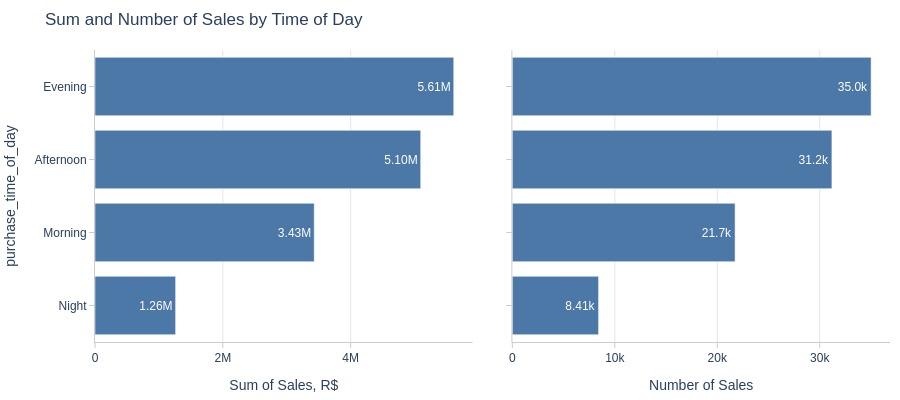
Key Observations:
Highest sales volume and revenue in evenings
Lowest at night
By Day of Week
pb.bar_groupby(y='purchase_weekday', show_count=True, to_slide=True)
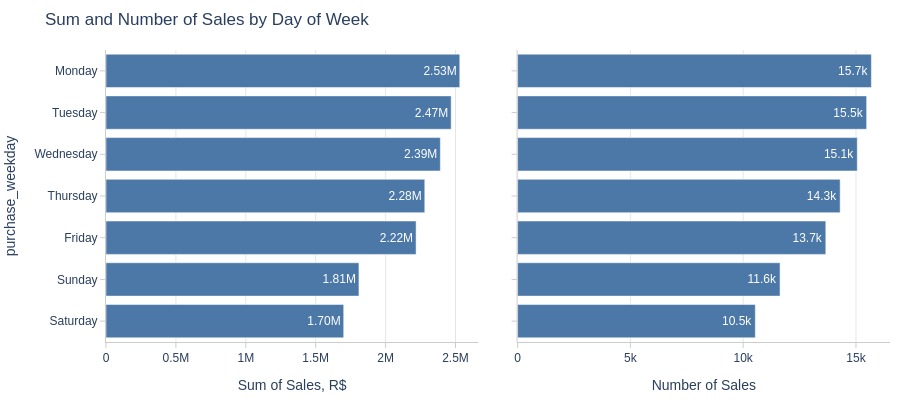
Key Observations:
Monday has highest sales volume/revenue
Saturday has lowest
By Weekday vs Weekend
pb.bar_groupby(y='purchase_day_type', show_count=True, to_slide=True)
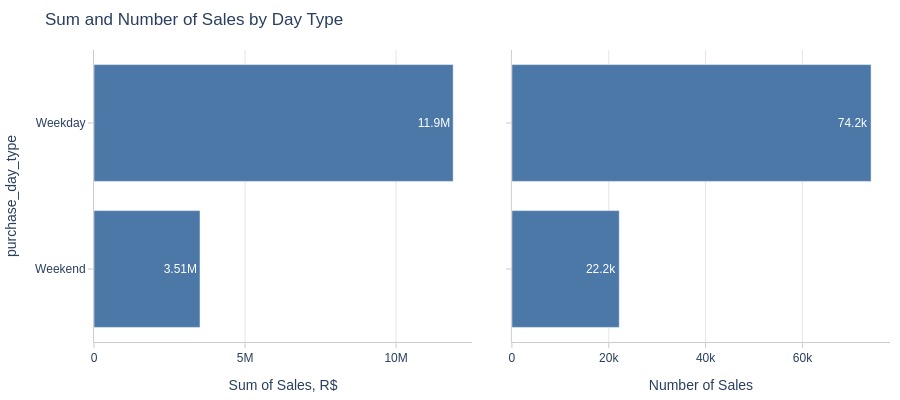
Key Observations:
Weekday sales/revenue significantly higher than weekends
By Day of the Week and Hour of the Day
fig = pb.heatmap(
x='purchase_hour'
, y='purchase_weekday'
, text_auto='.3s'
, labels={'color': 'Amount, R$'}
, title='Sales Amount by Day of the Week and Hour of the Day'
).update_layout(xaxis_dtick=1)
pb.to_slide(fig)
fig.show()
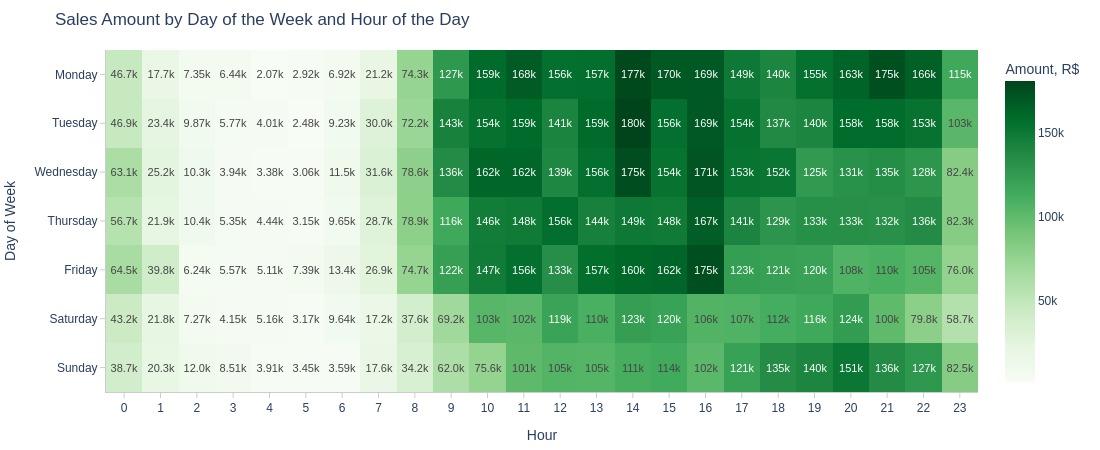
Key Observations:
1AM-8AM has lowest revenue across all weekdays
By Whether the Order is Delayed or Not
pb.bar_groupby(y='is_delayed', show_count=True)
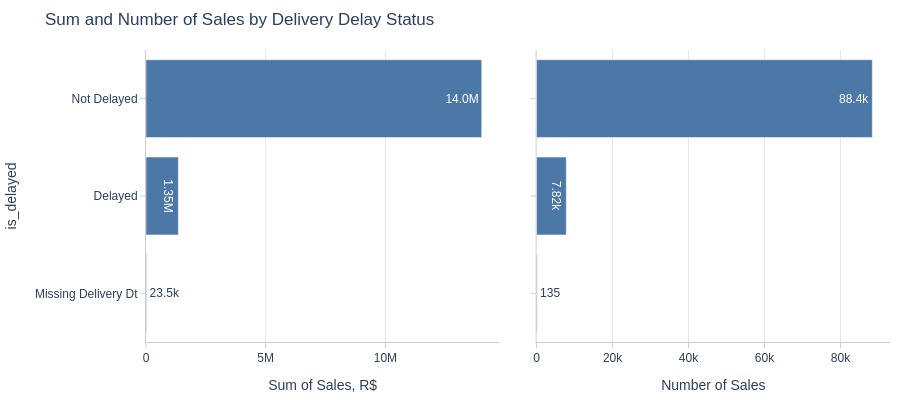
Key Observations:
Non-delayed orders have significantly higher sales/revenue
By Order Weight Category
pb.bar_groupby(y='order_total_weight_cat', show_count=True, to_slide=True)
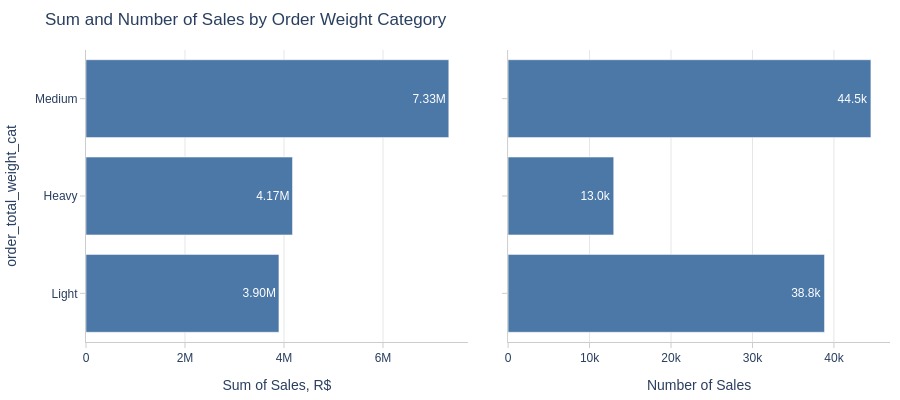
Key Observations:
Medium-weight orders generate more revenue than heavy/light
Light orders have higher quantity share but lower revenue share
Heavy orders are more expensive
By Presence of Installment Payments
pb.bar_groupby(y='order_has_installment', show_count=True, to_slide=True)

Key Observations:
Installment orders generate significantly more revenue despite similar order counts
Installment enables more expensive purchases
By Top Customer States
pb.bar_groupby(y='customer_state', show_count=True, to_slide=True)
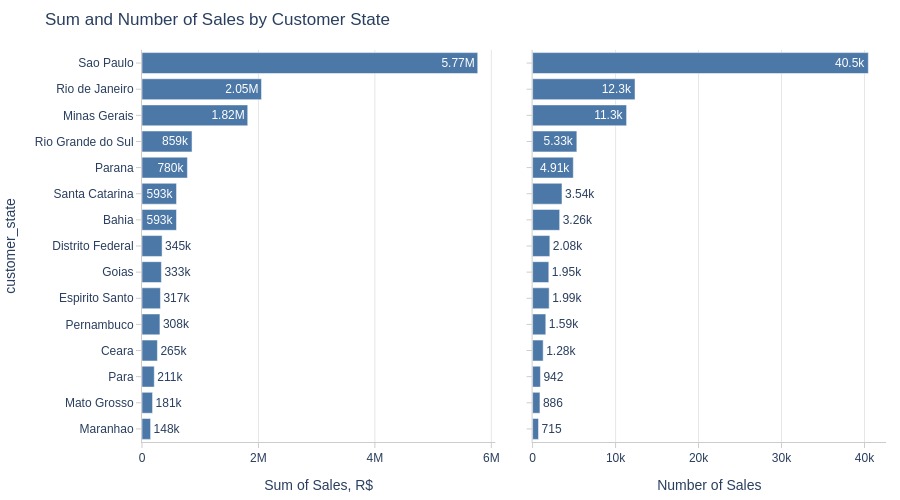
Key Observations:
São Paulo state dominates sales volume/revenue
Rio de Janeiro and Minas Gerais rank 2nd/3rd
By Top Customer Cities
pb.bar_groupby(y='customer_city', show_count=True, to_slide=True)
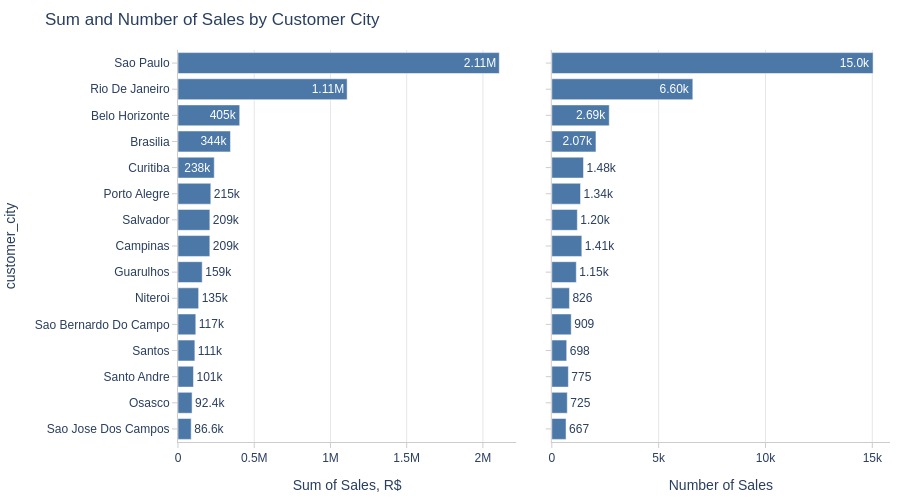
Key Observations:
São Paulo city leads in sales volume/revenue
Rio de Janeiro ranks second
By Review Score
pb.bar_groupby(y='order_avg_reviews_score', show_count=True, to_slide=True)
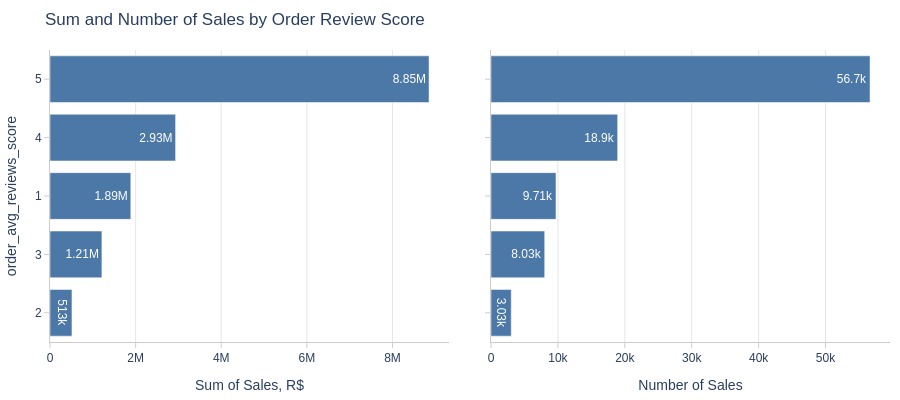
Key Observations:
5-star reviews have highest sales/revenue
2-star reviews have lowest
1-star reviews exceed 2/3-star in volume/revenue
By Payment Type
Since a single order can have multiple payments, we will measure transaction volume based on payment count.
pb.bar_groupby(
y='order_payment_types'
, show_count=True
, to_slide=True
)
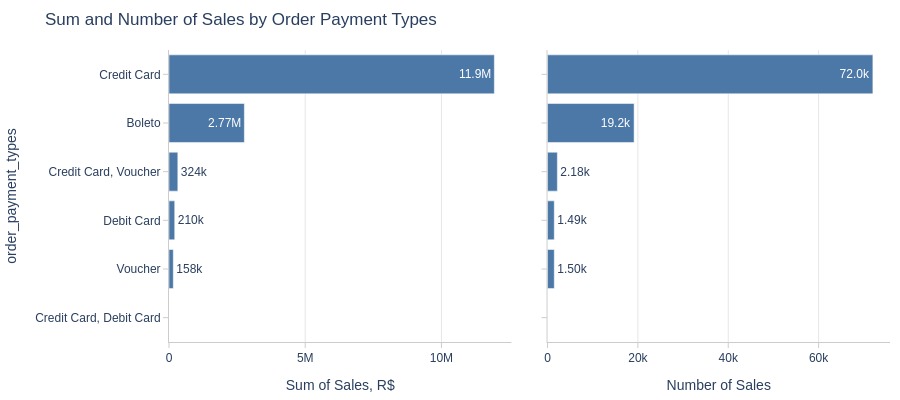
Key Observations:
Credit card leads payment methods (volume/revenue)
Boleto ranks second
By Product Category
For the category product split, we cannot take the payment amount. We will calculate the sum based on the product price and freight value.
The count will be determined by the number of items.
pb.bar_groupby(
y='order_general_product_categories'
, show_count=True
, to_slide=True
)
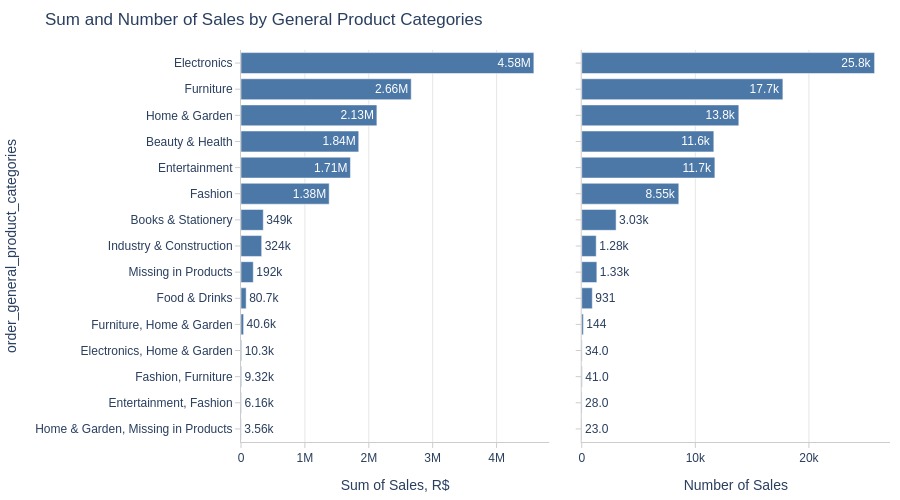
Key Observations:
Electronics leads categories (volume/revenue)
Furniture ranks second
Furniture has smaller price gap in quantity vs revenue
Average Order Value#
pb.configure(
df = df_sales
, metric = 'total_payment'
, metric_label = 'Average Order Value, R$'
, metric_label_for_distribution = 'Order Value, R$'
, agg_func = 'mean'
, title_base = 'Average Order Value and Number of Sales'
, axis_sort_order='descending'
, text_auto='.3s'
, update_fig={'xaxis2': {'title_text': 'Number of Sales'}}
)
Top Orders
pb.metric_top()
| total_payment | |
|---|---|
| order_id | |
| 03caa2c082116e1d31e67e9ae3700499 | 13,664.08 |
| 736e1922ae60d0d6a89247b851902527 | 7,274.88 |
| 0812eb902a67711a1cb742b3cdaa65ae | 6,929.31 |
| fefacc66af859508bf1a7934eab1e97f | 6,922.21 |
| f5136e38d1a14a4dbd87dff67da82701 | 6,726.66 |
| 2cc9089445046817a7539d90805e6e5a | 6,081.54 |
| a96610ab360d42a2e5335a3998b4718a | 4,950.34 |
| 199af31afc78c699f0dbf71fb178d4d4 | 4,764.34 |
| 8dbc85d1447242f3b127dda390d56e19 | 4,681.78 |
| 426a9742b533fc6fed17d1fd6d143d7e | 4,513.32 |
Let’s see at statistics and distribution of the metric.
pb.metric_info(
labels=dict(total_payment='Order Value, R$')
, title='Distribution of Order Value'
, upper_quantile=0.95
, hist_mode='dual_hist_trim'
)
| Summary | Percentiles | Detailed Stats | Value Counts | |||||||
|---|---|---|---|---|---|---|---|---|---|---|
| Total | 96.35k (100%) | Max | 13.66k | Mean | 159.83 | 77.57 | 250 (<1%) | |||
| Missing | --- | 99% | 1.05k | Trimmed Mean (10%) | 119.85 | 35 | 164 (<1%) | |||
| Distinct | 27.40k (28%) | 95% | 445.84 | Mode | 77.57 | 73.34 | 161 (<1%) | |||
| Non-Duplicate | 12.82k (13%) | 75% | 176.26 | Range | 13.65k | 116.94 | 131 (<1%) | |||
| Duplicates | 68.94k (72%) | 50% | 105.28 | IQR | 114.36 | 56.78 | 118 (<1%) | |||
| Dup. Values | 14.59k (15%) | 25% | 61.89 | Std | 218.93 | 107.78 | 118 (<1%) | |||
| Zeros | --- | 5% | 32.38 | MAD | 76.37 | 65 | 112 (<1%) | |||
| Negative | --- | 1% | 22.38 | Kurt | 249.10 | 86.15 | 106 (<1%) | |||
| Memory Usage | 1 | Min | 9.59 | Skew | 9.37 | 99.90 | 105 (<1%) | |||
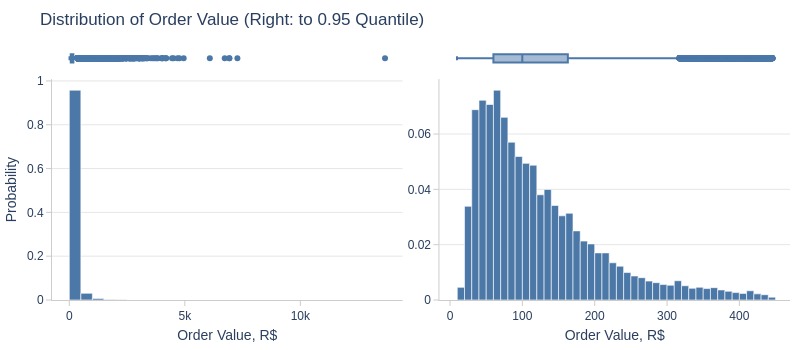
Key Observations:
75% of orders ≤177 R$
5% ≤33 R$
5% ≥445 R$
Many outliers >1000 R$
Let’s look by different dimensions.
By Season
Since 2018 has incomplete monthly data, it’s better to also analyze by year…
pb.bar_groupby(
x='purchase_season'
, color='purchase_year'
, title='Average Order Value by Season and Year'
)

Key Observations:
Summer 2017 had higher order values
Other seasons slightly higher in 2018
By Day of the Week and Hour of the Day
fig = pb.heatmap(
x='purchase_hour'
, y='purchase_weekday'
, text_auto='.1f'
, labels={'color': 'AOV, R$'}
, title='Average Order Value by Day of the Week and Hour of the Day'
).update_layout(xaxis_dtick=1)
pb.to_slide(fig)
fig.show()
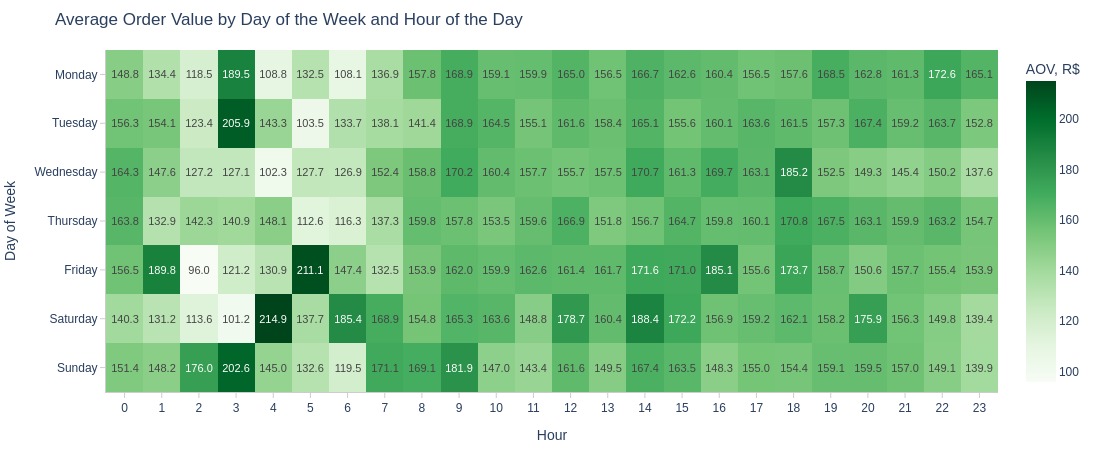
Key Observations:
Nighttime doesn’t always have lowest average order value
Some weekday nights show value peaks
By Whether the Order is Delayed or Not
pb.histogram(
color='is_delayed'
, upper_quantile=0.95
, mode='dual_box_trim'
, show_box=True
, show_hist=True
, show_kde=False
, nbins=30
).show()
pb.bar_groupby(
y='is_delayed'
, show_count=True
).show()
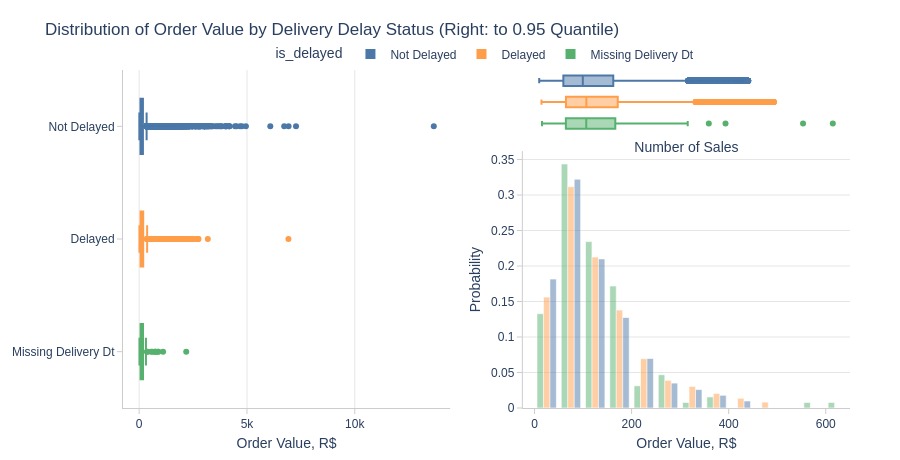
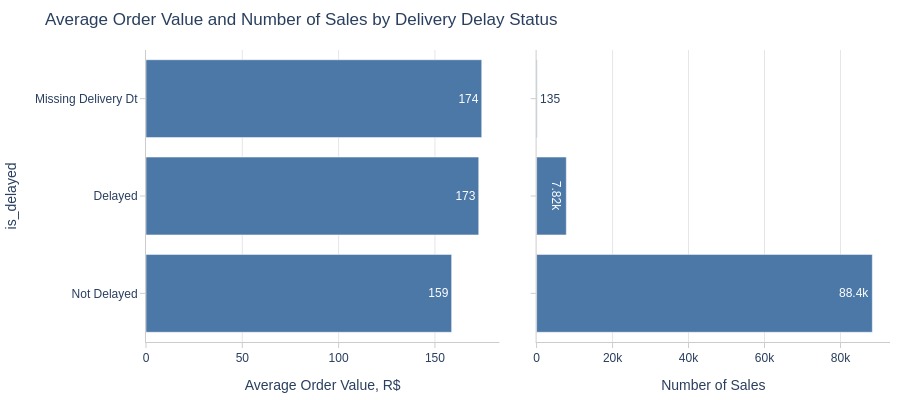
Key Observations:
Non-delayed orders have lower average values
By Order Weight Category
pb.histogram(
color='order_total_weight_cat'
, upper_quantile=0.95
, mode='dual_box_trim'
, show_box=True
, show_hist=True
, show_kde=False
, nbins=30
).show()
pb.bar_groupby(
y='order_total_weight_cat'
, show_count=True
).show()
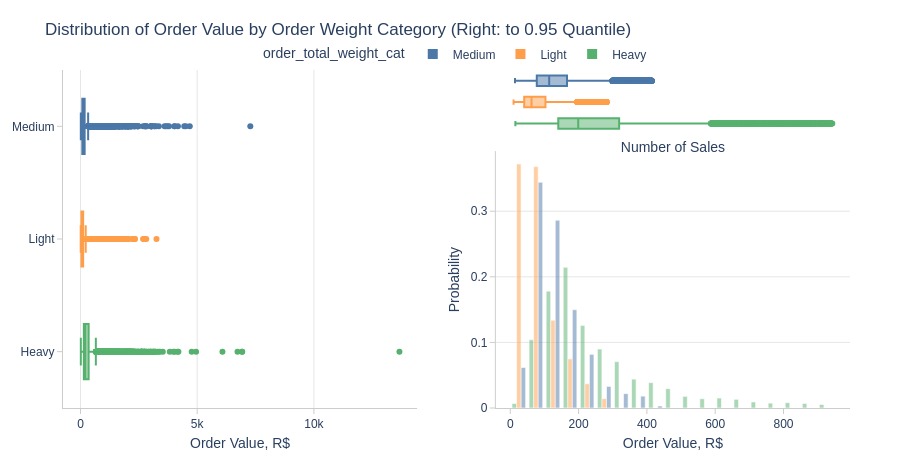
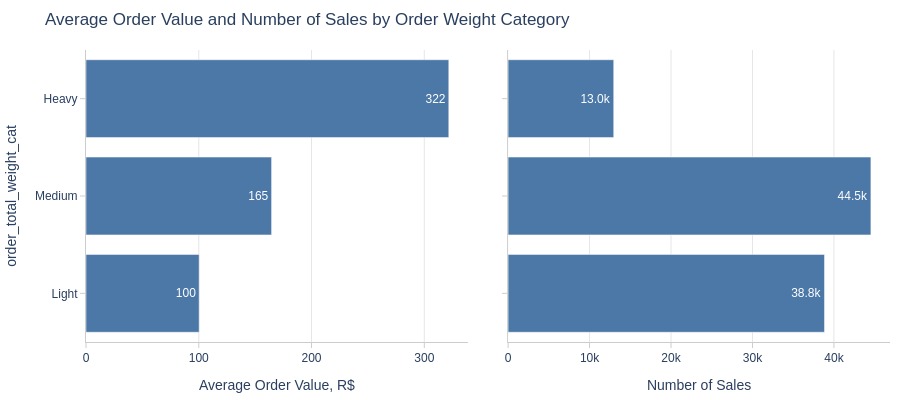
Key Observations:
Heavier orders have higher average values
By Presence of Installment Payments
pb.histogram(
color='order_has_installment'
, upper_quantile=0.95
, mode='dual_box_trim'
, show_box=True
, show_hist=True
, show_kde=False
, nbins=30
).show()
pb.bar_groupby(
y='order_has_installment'
, show_count=True
, to_slide=True
).show()
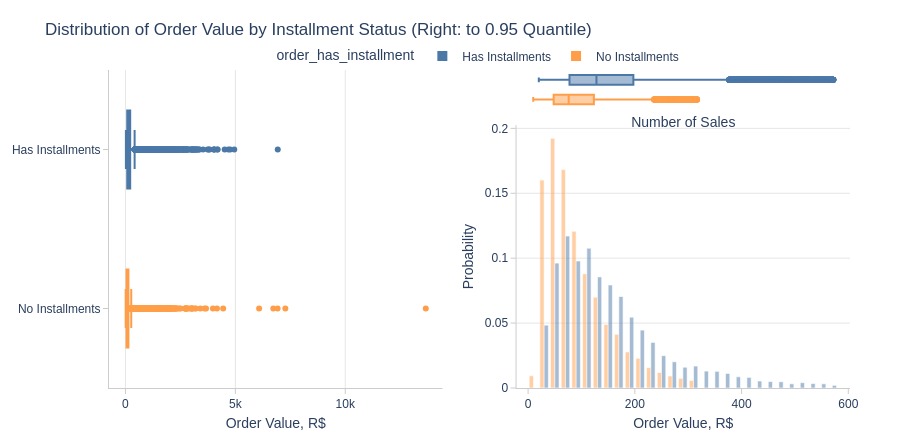

Key Observations:
Installment orders have much higher average values
By Top Customer States
pb.box(
y='customer_state'
, upper_quantile=0.95
, show_dual=True
).show()
pb.bar_groupby(
y='customer_state'
, show_count=True
, to_slide=True
).show()
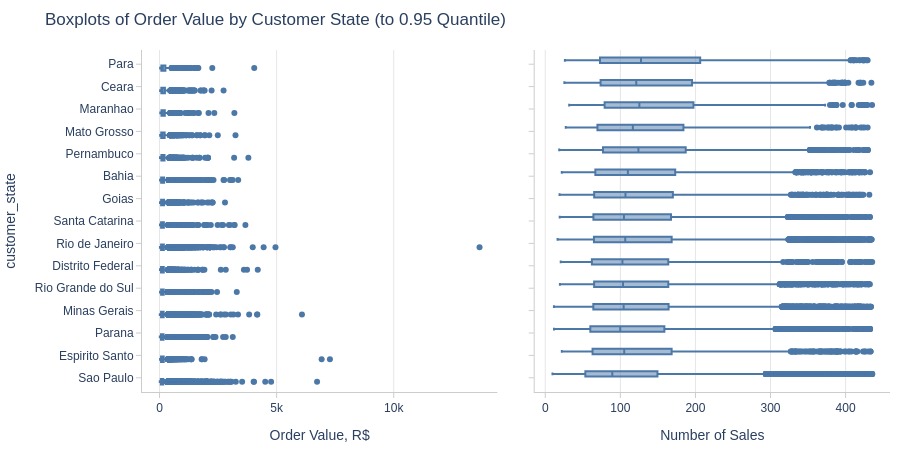
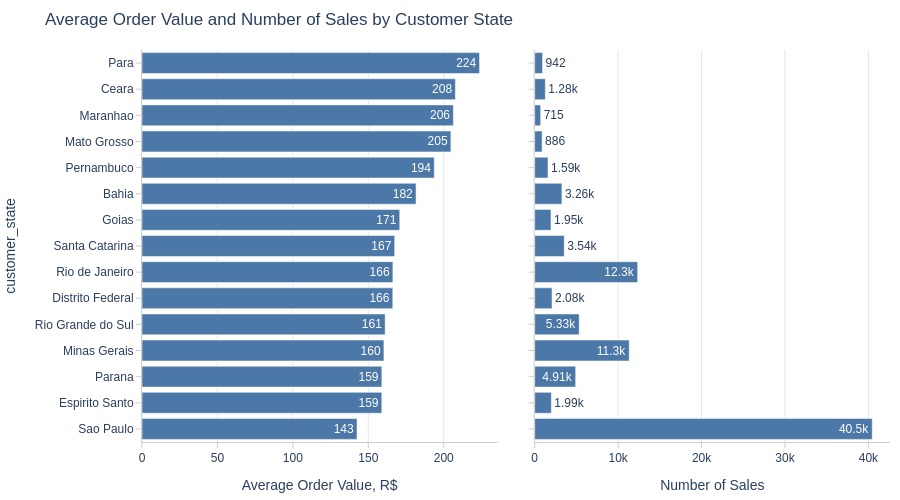
Key Observations:
São Paulo has most orders but lowest average value among top states
Para has highest average order value
By Top Customer Cities
pb.box(
y='customer_city'
, upper_quantile=0.95
, show_dual=True
).show()
pb.bar_groupby(
y='customer_city'
, show_count=True
, to_slide=True
).show()
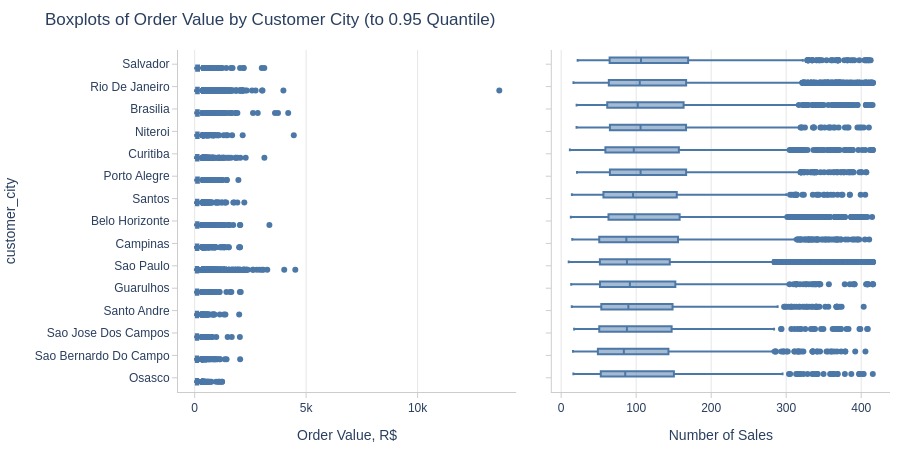
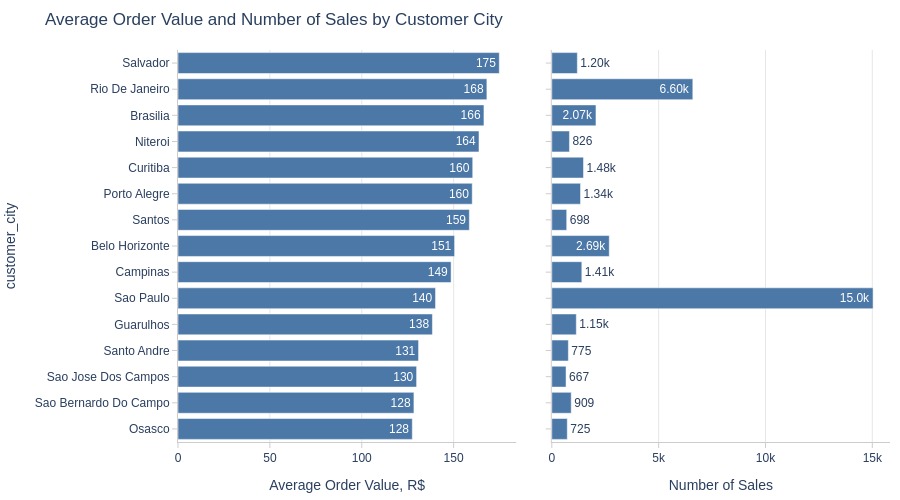
Key Observations:
Rio de Janeiro combines high volume with high average value
Salvador has highest average order value among top cities
By Review Score
pb.histogram(
color='order_avg_reviews_score'
, upper_quantile=0.95
, mode='dual_box_trim'
, show_box=True
, show_hist=False
, show_kde=True
, nbins=30
).show()
pb.bar_groupby(
y='order_avg_reviews_score'
, show_count=True
, to_slide=True
).show()

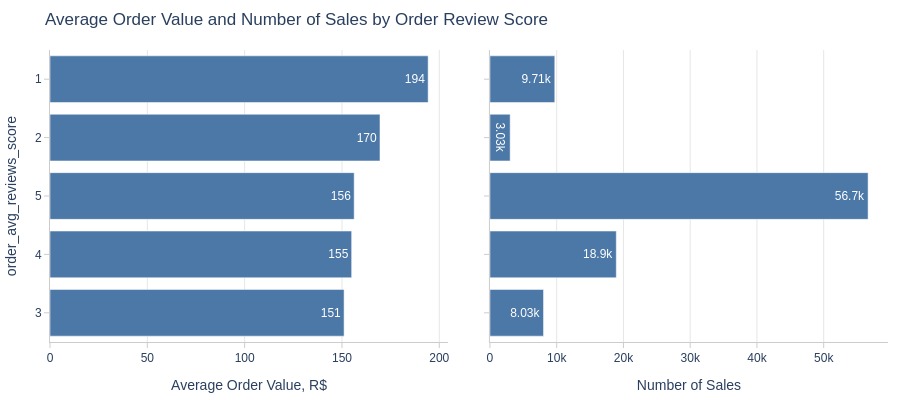
Key Observations:
1-star reviews have highest order values
2-star reviews rank second
Expensive orders receive more low ratings
Reviews Score#
pb.configure(
df = df_sales
, metric = 'order_avg_reviews_score'
, metric_label = 'Average Order Reviews Score'
, metric_label_for_distribution = 'Order Reviews Score'
, agg_func = 'mean'
, title_base = 'Average Order Reviews Score and Number of Sales'
, axis_sort_order='descending'
, text_auto='.3s'
, update_fig={'xaxis2': {'title_text': 'Number of Sales'}}
)
Let’s see at statistics and distribution of the metric.
pb.metric_info(
labels=dict(order_avg_reviews_score='Order Reviews Score')
, title='Distribution of Order Reviews Score'
, xaxis_type='category'
)
| Summary | Percentiles | Detailed Stats | Value Counts | |||||||
|---|---|---|---|---|---|---|---|---|---|---|
| Total | 96.35k (100%) | Max | 5 | Mean | 4.14 | 5 | 56.65k (59%) | |||
| Missing | --- | 99% | 5 | Trimmed Mean (10%) | 4.42 | 4 | 18.93k (20%) | |||
| Distinct | 5 (<1%) | 95% | 5 | Mode | 5 | 1 | 9.71k (10%) | |||
| Non-Duplicate | 0 (<1%) | 75% | 5 | Range | 4 | 3 | 8.03k (8%) | |||
| Duplicates | 96.34k (99%) | 50% | 5 | IQR | 1 | 2 | 3.03k (3%) | |||
| Dup. Values | 5 (<1%) | 25% | 4 | Std | 1.30 | |||||
| Zeros | --- | 5% | 1 | MAD | 0 | |||||
| Negative | --- | 1% | 1 | Kurt | 0.84 | |||||
| Memory Usage | 1 | Min | 1 | Skew | -1.45 | |||||

Key Observations:
59% of orders have 5-star reviews
Let’s look by different dimensions.
By Season
pb.bar_groupby(
x='purchase_season'
, color='purchase_year'
, title='Average Order Reviews Score by Season and Year'
)
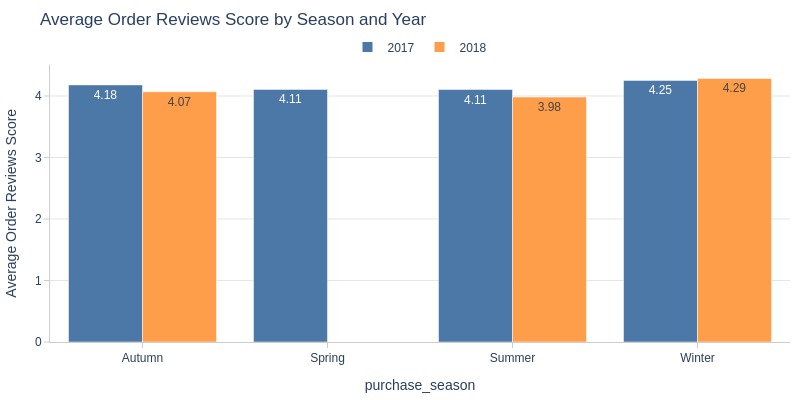
Key Observations:
Winter 2018 had slightly higher ratings
Other seasons slightly higher in 2017
By Day of the Week and Hour of the Day
pb.heatmap(
x='purchase_hour'
, y='purchase_weekday'
, text_auto='.1f'
, title='Average Order Reviews Score by Day of the Week and Hour of the Day'
, labels=dict(color = 'Score')
).update_layout(xaxis_dtick=1)
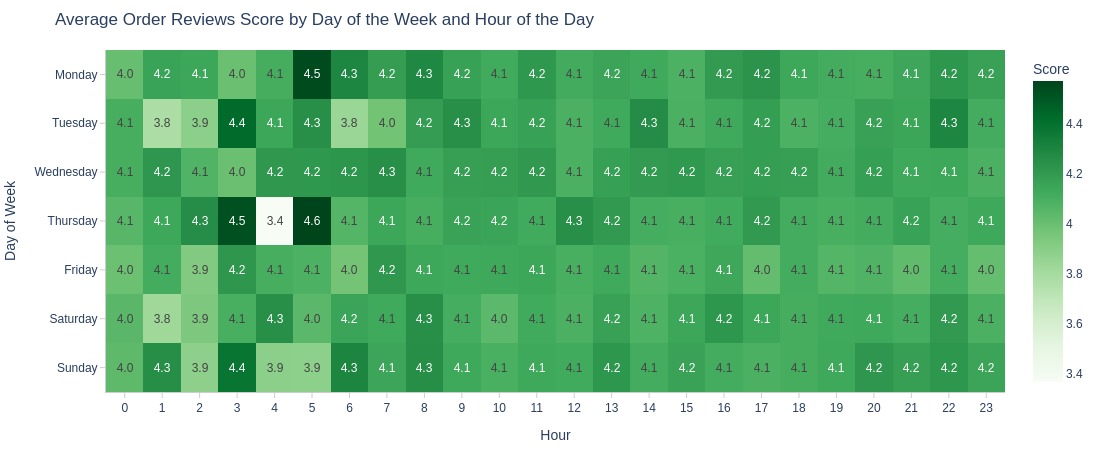
Key Observations:
Nighttime shows rating extremes (especially Thursdays)
By Delivery Delay Status
pb.cat_compare(
cat2='is_delayed'
, visible_graphs=[2]
)
pb.bar_groupby(
y='is_delayed'
, show_count=True
, to_slide=True
).show()
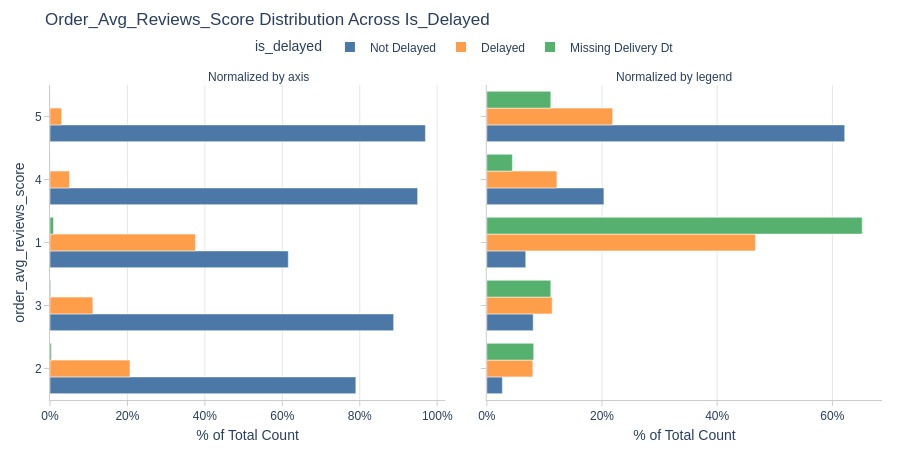
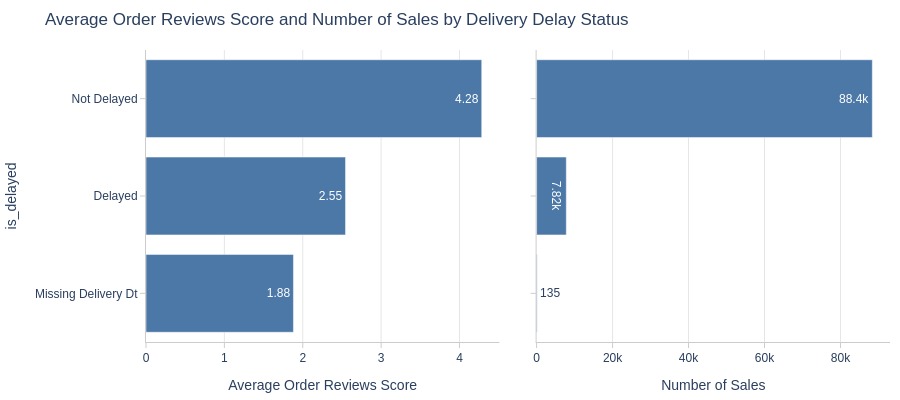
Key Observations:
Non-delayed orders have significantly higher ratings
Higher 5-star share for on-time deliveries
“Unknown” delivery status orders mostly get 1-star
By Delivery Time Category
pb.cat_compare(
cat2='delivery_time_days_cat'
, visible_graphs=[2]
)
pb.bar_groupby(
y='delivery_time_days_cat'
, show_count=True
).show()
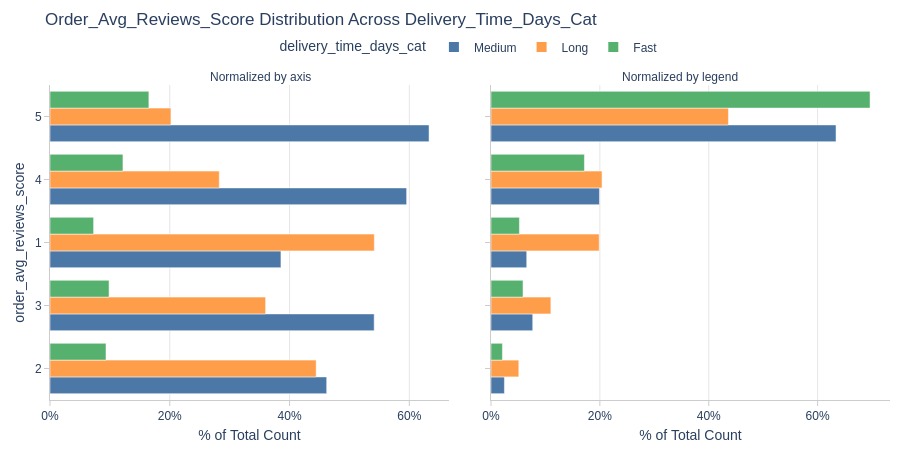
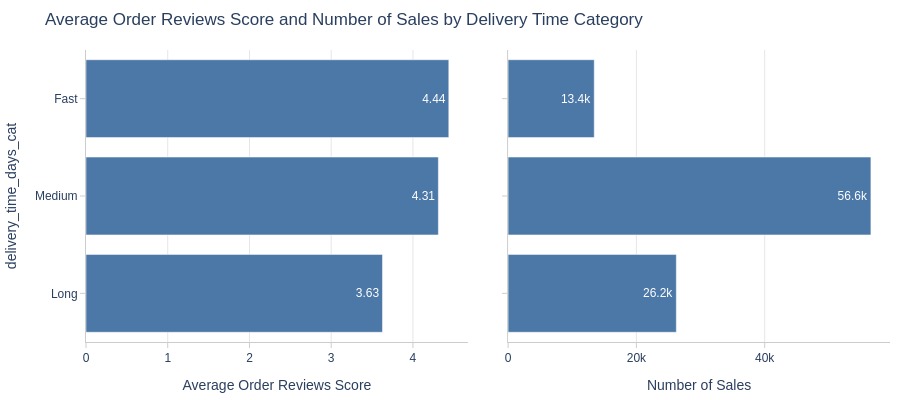
Key Observations:
Faster deliveries get better ratings
By Customer State
pb.cat_compare(
cat2='customer_state'
, visible_graphs=[2]
, trim_top_n_cat2=7
)
fig = pb.bar_groupby(
y='customer_state'
, show_count=True
).update_layout(xaxis_domain=[0, 0.4], xaxis2_domain=[0.6, 1])
pb.to_slide(fig)
fig.show()
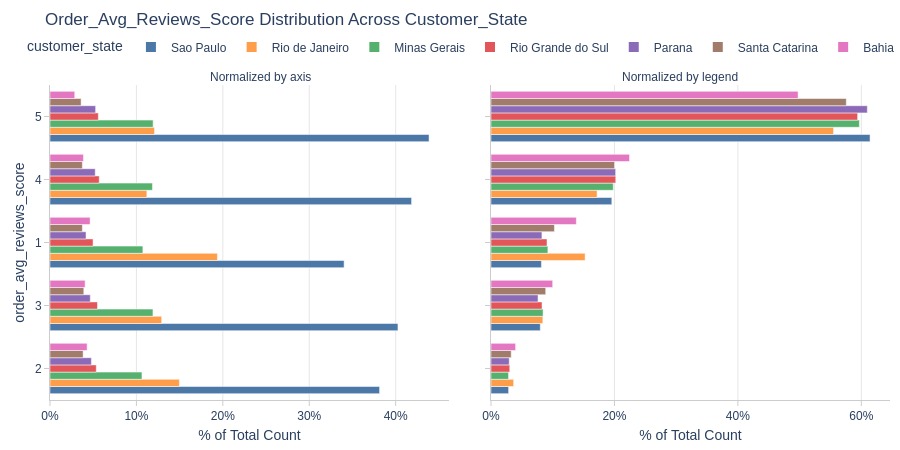
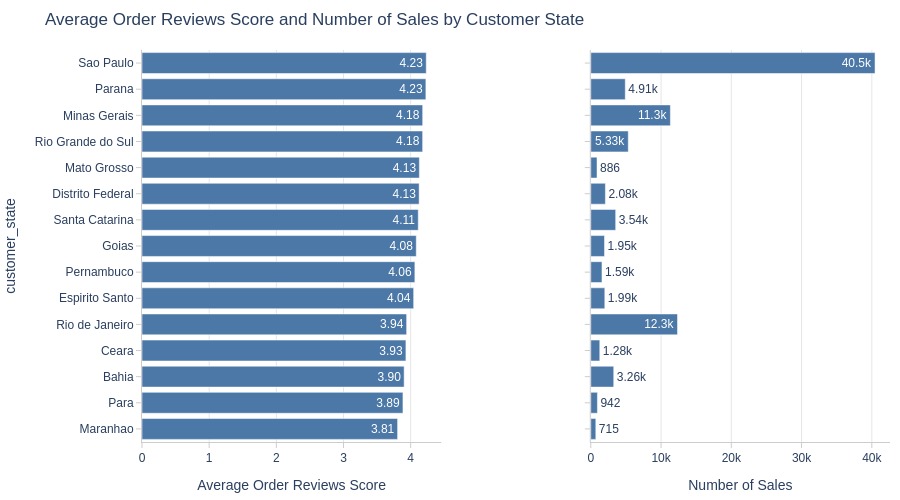
Key Observations:
Maranhão has lowest average rating among top states
Rio de Janeiro and Bahia have highest 1-star share
By Customer City
pb.cat_compare(
cat2='customer_city'
, visible_graphs=[2]
, trim_top_n_cat2=7
)
pb.bar_groupby(
y='customer_city'
, show_count=True
).update_layout(xaxis_domain=[0, 0.4], xaxis2_domain=[0.6, 1]).show()

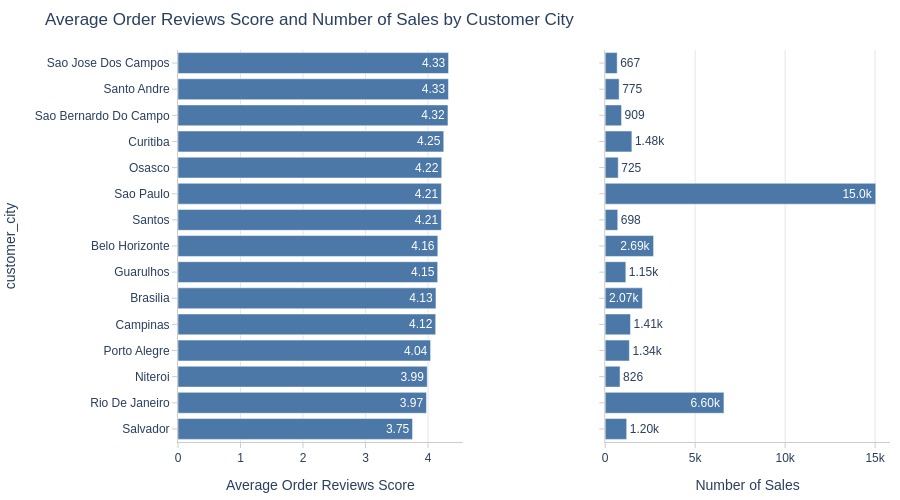
Key Observations:
Rio de Janeiro and Porto Alegre have notable 1-star concentrations
Order Weight#
pb.configure(
df = df_sales
, metric = 'total_weight_kg'
, metric_label = 'Average Weight of Order, kg'
, metric_label_for_distribution = 'Weight of Order, kg'
, title_base = 'Average Weight of Order and Number of Sales'
, agg_func = 'mean'
, axis_sort_order='descending'
, text_auto='.3s'
, update_fig={'xaxis2': {'title_text': 'Number of Sales'}}
)
Top Orders
pb.metric_top()
| total_weight_kg | |
|---|---|
| order_id | |
| 9aec4e1ae90b23c7bf2d2b3bfafbd943 | 184.40 |
| 2455cbeb73fd04b170ca2504662f95ce | 154.20 |
| 8f6f263a5e96515d5534199b74cb7748 | 144.30 |
| be382a9e1ed25128148b97d6bfdb21af | 129.34 |
| cf4659487be50c0c317cff3564c4a840 | 112.20 |
| 53cbc02ffe278ca84b6f4920d9d3ecd5 | 108.50 |
| 60b570df9018c6b6441017314a2dd081 | 98.40 |
| f60ce04ff8060152c83c7c97e246d6a8 | 97.00 |
| 1446ae966d68c3abad1ca3a3ce58033e | 96.80 |
| 35990049382e07dba1a9ef3550cad655 | 93.90 |
Let’s see at statistics and distribution of the metric.
pb.metric_info(
labels=dict(total_weight_kg='Weight of Order, kg')
, title='Distribution of Weight of Order'
, upper_quantile=0.99
, hist_mode='dual_hist_trim'
)
| Summary | Percentiles | Detailed Stats | Value Counts | |||||||
|---|---|---|---|---|---|---|---|---|---|---|
| Total | 96.35k (100%) | Max | 184.40 | Mean | 2.39 | 0.20 | 5.36k (6%) | |||
| Missing | --- | 99% | 22.35 | Trimmed Mean (10%) | 1.30 | 0.15 | 4.16k (4%) | |||
| Distinct | 1.48k (2%) | 95% | 10.50 | Mode | 0.20 | 0.30 | 3.69k (4%) | |||
| Non-Duplicate | 384 (<1%) | 75% | 2.05 | Range | 184.40 | 0.25 | 3.69k (4%) | |||
| Duplicates | 94.87k (98%) | 50% | 0.75 | IQR | 1.75 | 0.40 | 3.30k (3%) | |||
| Dup. Values | 1.09k (1%) | 25% | 0.30 | Std | 4.77 | 0.10 | 2.87k (3%) | |||
| Zeros | 5 (<1%) | 5% | 0.15 | MAD | 0.82 | 0.35 | 2.75k (3%) | |||
| Negative | --- | 1% | 0.10 | Kurt | 96.51 | 0.50 | 2.36k (2%) | |||
| Memory Usage | 1 | Min | 0 | Skew | 6.58 | 0.60 | 2.27k (2%) | |||
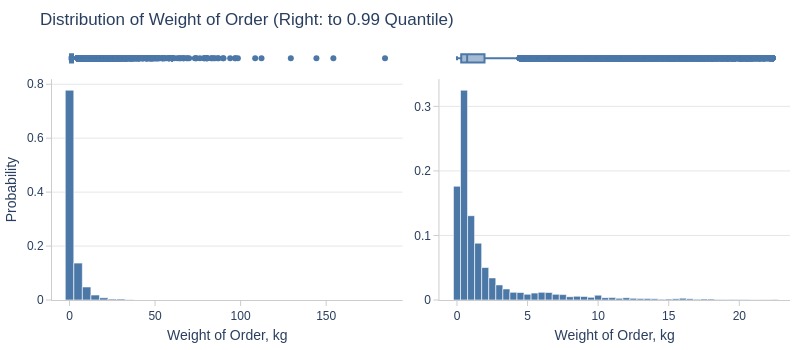
Key Observations:
75% of orders ≤2kg
5% ≤150g
5% ≥10kg
Let’s look by different dimensions.
By Season
Since 2018 has incomplete monthly data, it’s better to also analyze by year…
pb.bar_groupby(
x='purchase_season'
, color='purchase_year'
, title='Average Weight of Order by Season and Year'
)
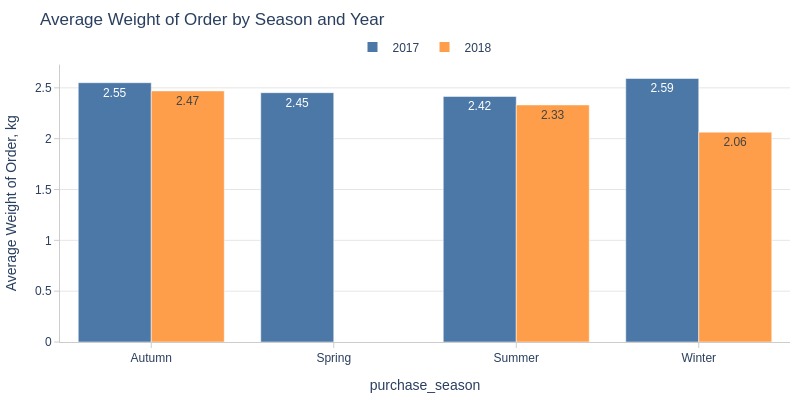
Key Observations:
2017 had heavier orders across all seasons
By Time of Day
pb.histogram(
color='purchase_time_of_day'
, upper_quantile=0.95
, mode='dual_box_trim'
, show_box=True
, show_hist=False
, show_kde=True
).show()
pb.bar_groupby(
y='purchase_time_of_day'
, show_count=True
).show()
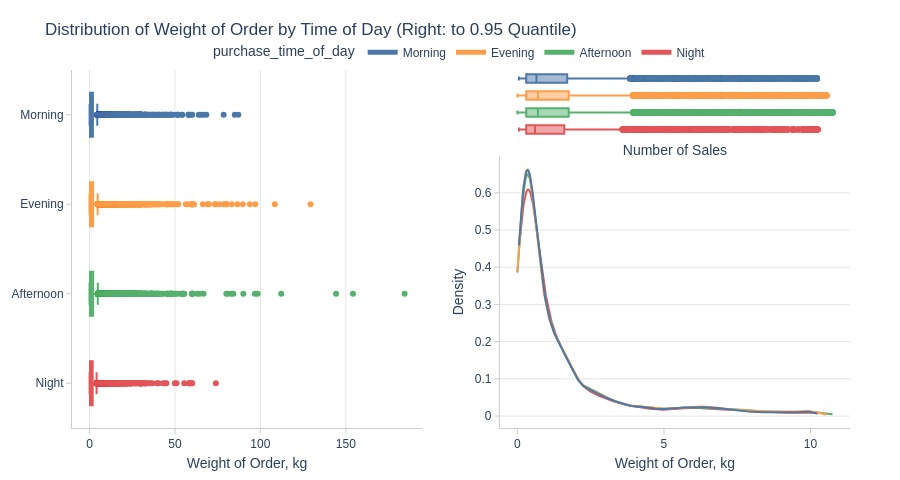

Key Observations:
Afternoons have heaviest orders
Nights have lightest
By Whether the Order is Delayed or Not
pb.histogram(
color='is_delayed'
, upper_quantile=0.95
, mode='dual_box_trim'
, show_box=True
, show_hist=False
, show_kde=True
).show()
pb.bar_groupby(
y='is_delayed'
, show_count=True
, to_slide=True
).show()
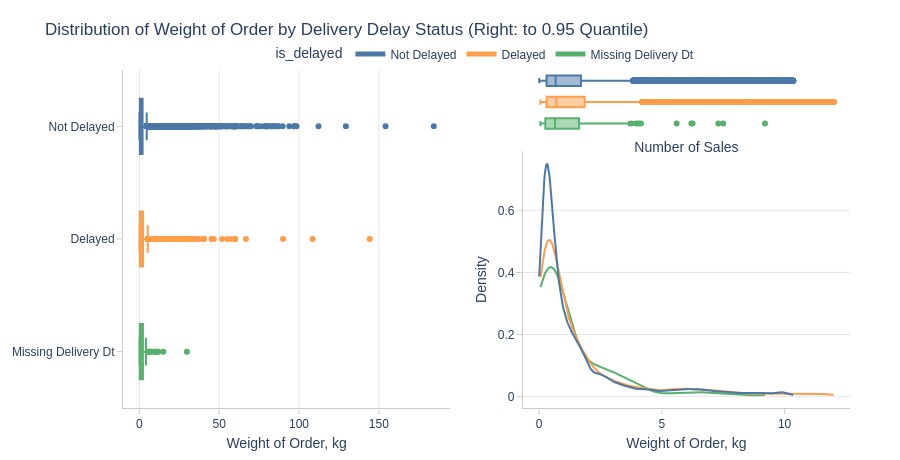
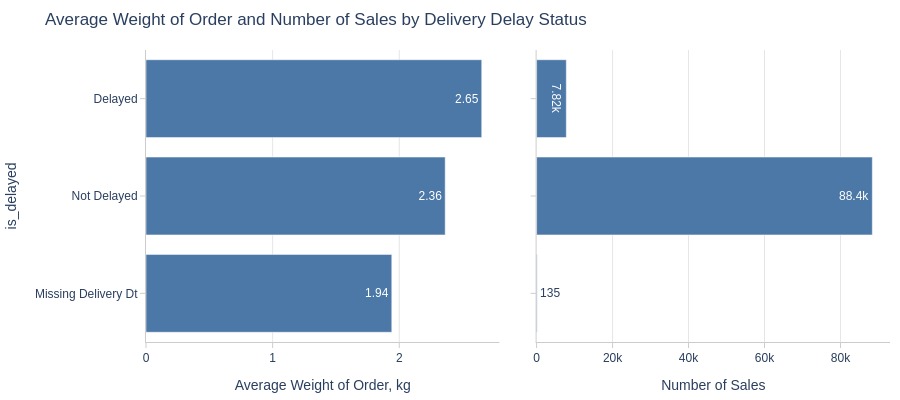
Key Observations:
Delayed orders are heavier
By Presence of Installment Payments
pb.histogram(
color='order_has_installment'
, upper_quantile=0.95
, mode='dual_box_trim'
, show_box=True
, show_hist=False
, show_kde=True
).show()
pb.bar_groupby(
y='order_has_installment'
, show_count=True
, to_slide=True
)
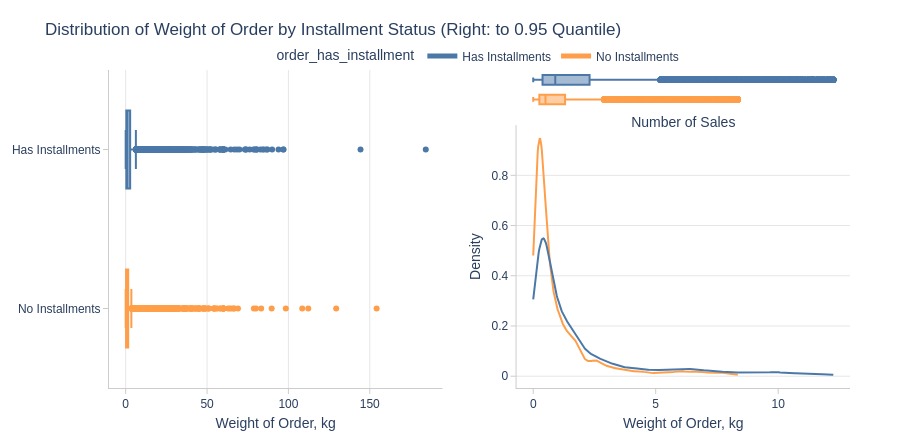
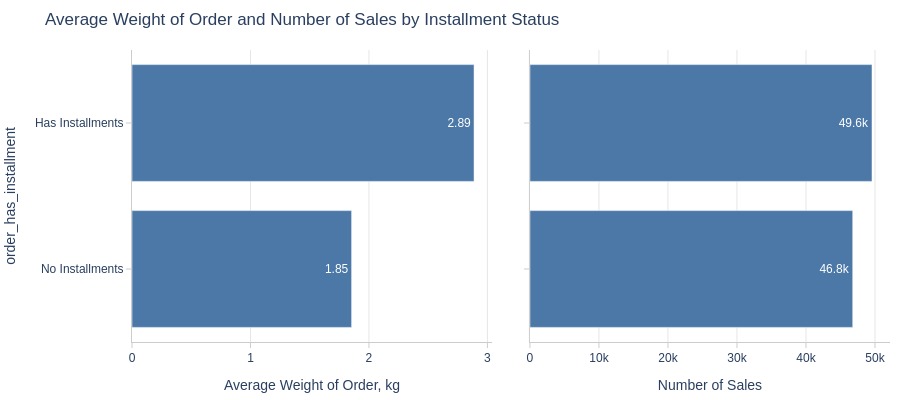
Key Observations:
Installment orders are heavier
By Top Customer States
pb.box(
y='customer_state'
, upper_quantile=0.95
, show_dual=True
).show()
pb.bar_groupby(
y='customer_state'
, show_count=True
, to_slide=True
).show()
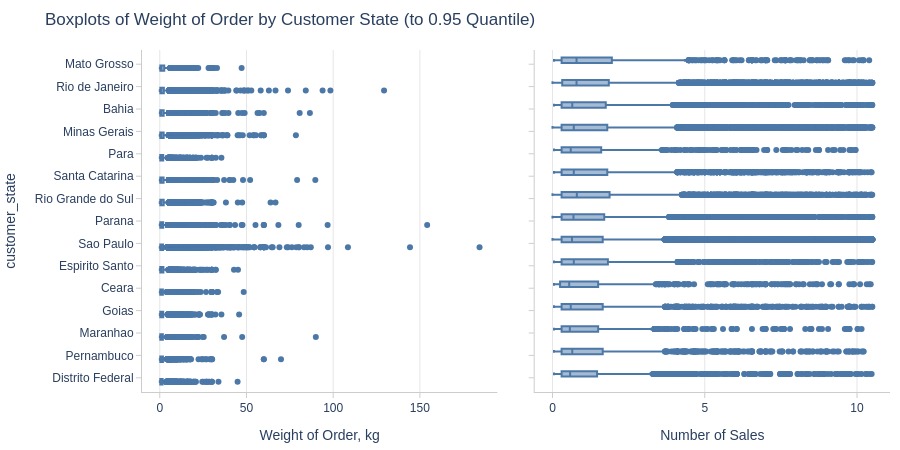
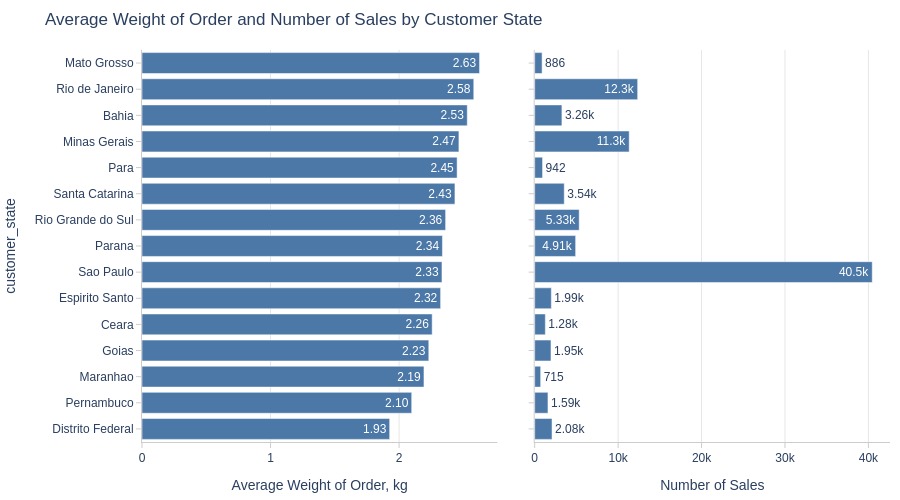
Key Observations:
Mato Grosso has heaviest average orders among top states
By Top Customer Cities
pb.box(
y='customer_city'
, upper_quantile=0.95
, show_dual=True
).show()
pb.bar_groupby(
y='customer_city'
, show_count=True
, to_slide=True
)
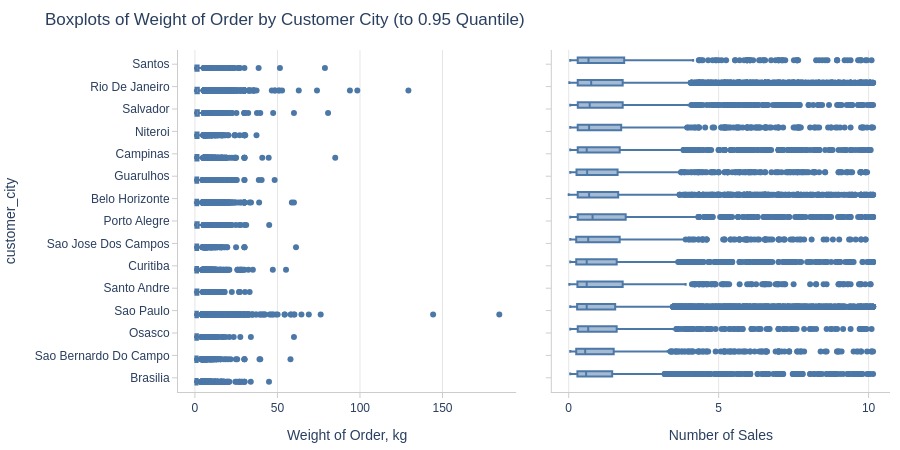
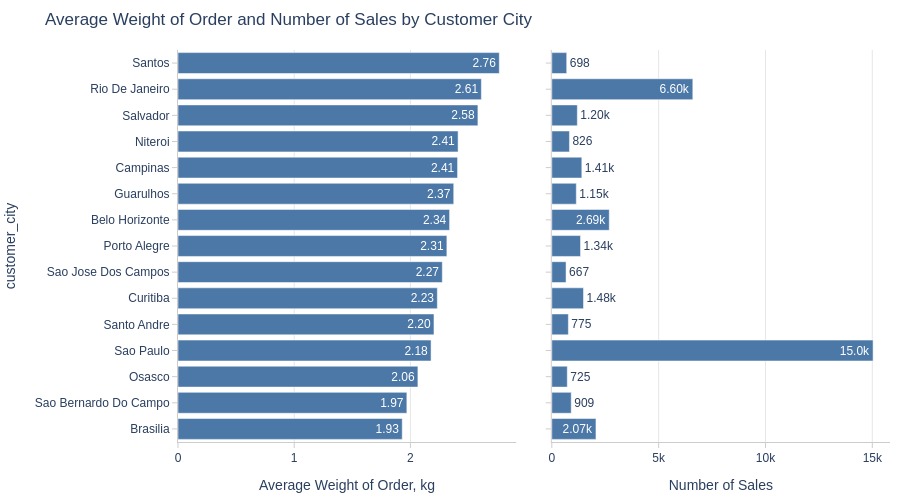
Key Observations:
Santos and Rio de Janeiro have heaviest average orders
By Review Score
pb.bar_groupby(y='order_avg_reviews_score', show_count=True, to_slide=True)
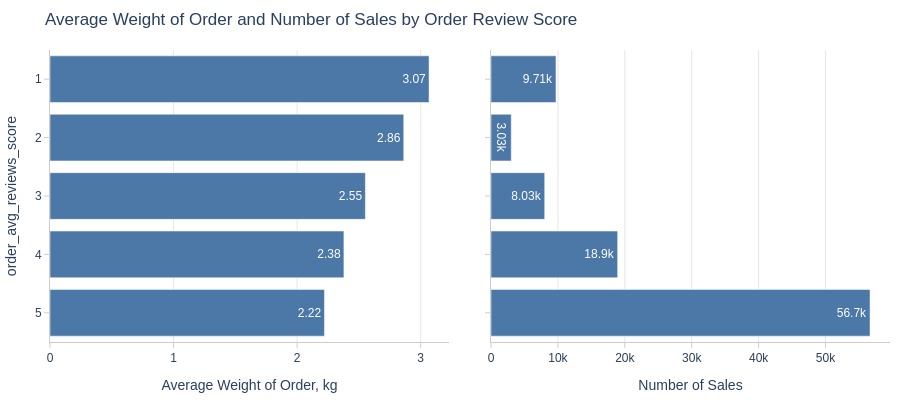
Key Observations:
1-star reviews have significantly heavier orders
2-star reviews rank second
Heavy orders receive lower ratings
Number of Products per Order#
pb.configure(
df = df_sales
, metric = 'products_cnt'
, metric_label = 'Average Number of Products in Order'
, metric_label_for_distribution = 'Number of Products in Order'
, title_base = 'Number of Products in Order and Number of Sales'
, agg_func = 'mean'
, axis_sort_order='descending'
, text_auto='.3s'
, update_fig={'xaxis2': {'title_text': 'Number of Sales'}}
)
Top Orders
pb.metric_top()
| products_cnt | |
|---|---|
| order_id | |
| 8272b63d03f5f79c56e9e4120aec44ef | 21.00 |
| 1b15974a0141d54e36626dca3fdc731a | 20.00 |
| ab14fdcfbe524636d65ee38360e22ce8 | 20.00 |
| 428a2f660dc84138d969ccd69a0ab6d5 | 15.00 |
| 9ef13efd6949e4573a18964dd1bbe7f5 | 15.00 |
| 9bdc4d4c71aa1de4606060929dee888c | 14.00 |
| 73c8ab38f07dc94389065f7eba4f297a | 14.00 |
| 37ee401157a3a0b28c9c6d0ed8c3b24b | 13.00 |
| 2c2a19b5703863c908512d135aa6accc | 12.00 |
| af822dacd6f5cff7376413c03a388bb7 | 12.00 |
Let’s see at statistics and distribution of the metric.
pb.metric_info(
labels=dict(products_cnt='Number of Products in Order')
, title='Distribution of Number of Products in Order'
)
| Summary | Percentiles | Detailed Stats | Value Counts | |||||||
|---|---|---|---|---|---|---|---|---|---|---|
| Total | 96.35k (100%) | Max | 21 | Mean | 1.14 | 1 | 86.74k (90%) | |||
| Missing | --- | 99% | 3 | Trimmed Mean (10%) | 1 | 2 | 7.38k (8%) | |||
| Distinct | 17 (<1%) | 95% | 2 | Mode | 1 | 3 | 1.30k (1%) | |||
| Non-Duplicate | 2 (<1%) | 75% | 1 | Range | 20 | 4 | 493 (<1%) | |||
| Duplicates | 96.33k (99%) | 50% | 1 | IQR | 0 | 5 | 192 (<1%) | |||
| Dup. Values | 15 (<1%) | 25% | 1 | Std | 0.54 | 6 | 189 (<1%) | |||
| Zeros | --- | 5% | 1 | MAD | 0 | 7 | 22 (<1%) | |||
| Negative | --- | 1% | 1 | Kurt | 116.86 | 8 | 8 (<1%) | |||
| Memory Usage | 1 | Min | 1 | Skew | 7.57 | 10 | 8 (<1%) | |||
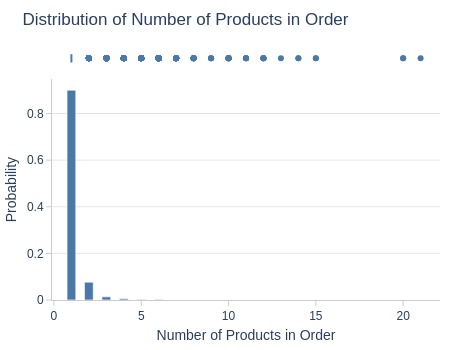
Key Observations:
90% of orders contain single product
Two anomalies had 20-21 products
Let’s look by different dimensions.
By Whether the Order is Delayed or Not
pb.bar_groupby(
y='is_delayed'
, show_count=True
).show()
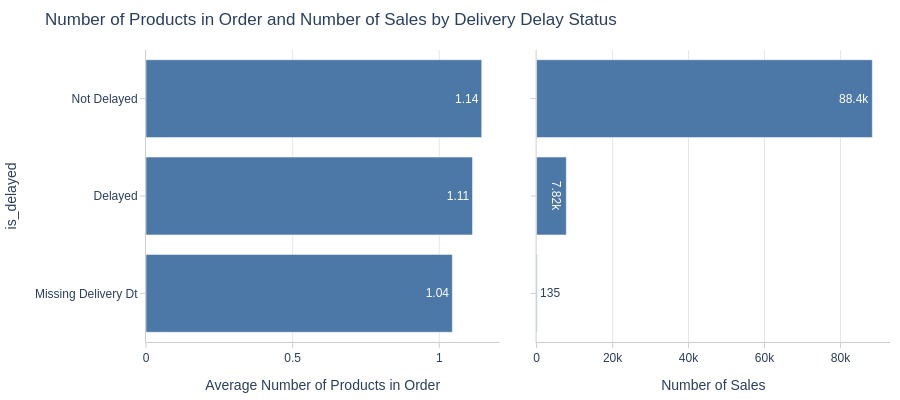
Key Observations:
Non-delayed orders have slightly more products
By Review Score
pb.bar_groupby(y='order_avg_reviews_score', show_count=True, to_slide=True)

Key Observations:
1/2-star reviews have more products per order
Product Price per Order#
pb.configure(
df = df_sales
, metric = 'avg_products_price'
, metric_label = 'Average Product Price in Order, R$'
, metric_label_for_distribution = 'Product Price in Order, R$'
, agg_func = 'mean'
, title_base = 'Average Product Price in Order and Number of Sales'
, axis_sort_order='descending'
, text_auto='.3s'
, update_fig={'xaxis2': {'title_text': 'Number of Sales'}}
)
Top Orders
pb.metric_top()
| avg_products_price | |
|---|---|
| order_id | |
| 0812eb902a67711a1cb742b3cdaa65ae | 6,735.00 |
| fefacc66af859508bf1a7934eab1e97f | 6,729.00 |
| f5136e38d1a14a4dbd87dff67da82701 | 6,499.00 |
| a96610ab360d42a2e5335a3998b4718a | 4,799.00 |
| 199af31afc78c699f0dbf71fb178d4d4 | 4,690.00 |
| 8dbc85d1447242f3b127dda390d56e19 | 4,590.00 |
| 426a9742b533fc6fed17d1fd6d143d7e | 4,399.87 |
| 68101694e5c5dc7330c91e1bbc36214f | 4,099.99 |
| b239ca7cd485940b31882363b52e6674 | 4,059.00 |
| 86c4eab1571921a6a6e248ed312f5a5a | 3,999.90 |
Let’s see at statistics and distribution of the metric.
pb.metric_info(
labels=dict(avg_products_price='Average Product Price in Order, R$')
, title='Distribution of Average Product Price in Order'
, upper_quantile=0.99
, hist_mode='dual_hist_trim'
)
| Summary | Percentiles | Detailed Stats | Value Counts | |||||||
|---|---|---|---|---|---|---|---|---|---|---|
| Total | 96.35k (100%) | Max | 6.74k | Mean | 125.24 | 59.90 | 1.96k (2%) | |||
| Missing | --- | 99% | 899.90 | Trimmed Mean (10%) | 90.41 | 69.90 | 1.70k (2%) | |||
| Distinct | 7.01k (7%) | 95% | 362.86 | Mode | 59.90 | 49.90 | 1.58k (2%) | |||
| Non-Duplicate | 3.51k (4%) | 75% | 139.90 | Range | 6.73k | 89.90 | 1.30k (1%) | |||
| Duplicates | 89.34k (93%) | 50% | 79 | IQR | 97.95 | 99.90 | 1.23k (1%) | |||
| Dup. Values | 3.50k (4%) | 25% | 41.95 | Std | 189.82 | 39.90 | 1.07k (1%) | |||
| Zeros | --- | 5% | 18.49 | MAD | 63.90 | 29.90 | 1.04k (1%) | |||
| Negative | --- | 1% | 10.99 | Kurt | 119.27 | 79.90 | 1.04k (1%) | |||
| Memory Usage | 1 | Min | 0.85 | Skew | 7.87 | 19.90 | 990 (1%) | |||
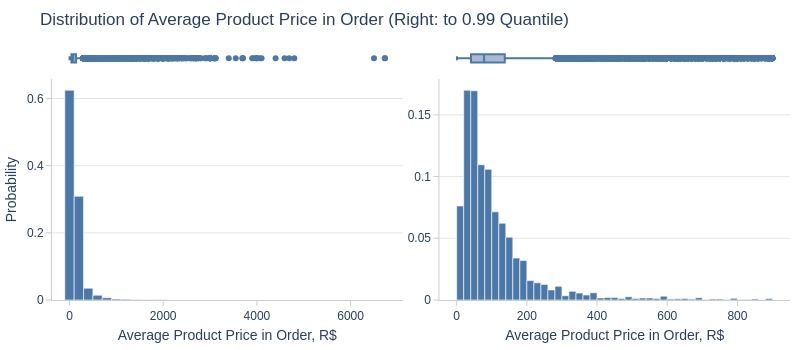
Key Observations:
75% of orders have average product price ≤140 R$
5% have ≥363 R$
Let’s look by different dimensions.
By Season
Since 2018 has incomplete monthly data, it’s better to also analyze by year…
pb.bar_groupby(
x='purchase_season'
, color='purchase_year'
, title='Average Product Price in Order by Season and Year'
)
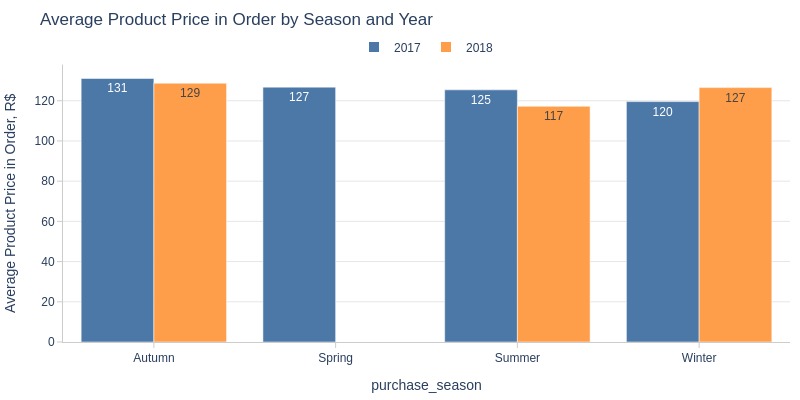
Key Observations:
Summer/fall 2017 had higher product prices
Winter 2018 was higher
By Time of Day
pb.histogram(
color='purchase_time_of_day'
, upper_quantile=0.95
, mode='dual_box_trim'
, show_box=True
, show_hist=False
, show_kde=True
).show()
pb.bar_groupby(
y='purchase_time_of_day'
, show_count=True
).show()
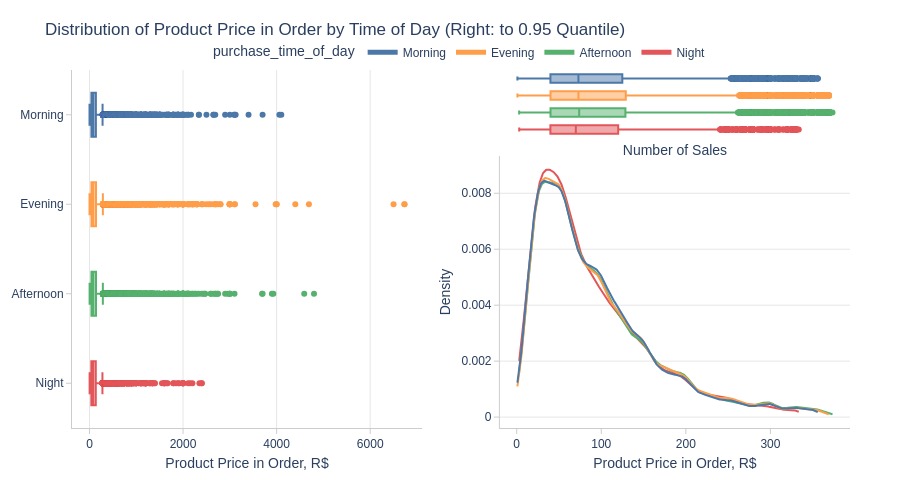
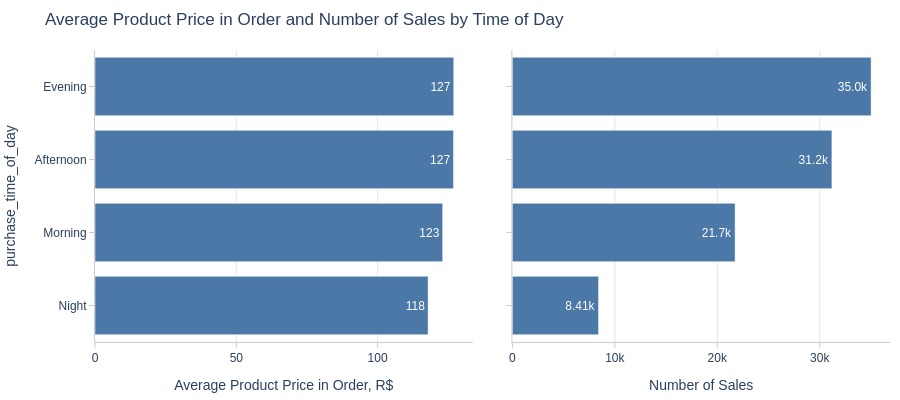
Key Observations:
Nighttime has lower product prices
By Whether the Order is Delayed or Not
pb.histogram(
color='is_delayed'
, upper_quantile=0.95
, mode='dual_box_trim'
, show_box=True
, show_hist=False
, show_kde=True
).show()
pb.bar_groupby(
y='is_delayed'
, show_count=True
).show()
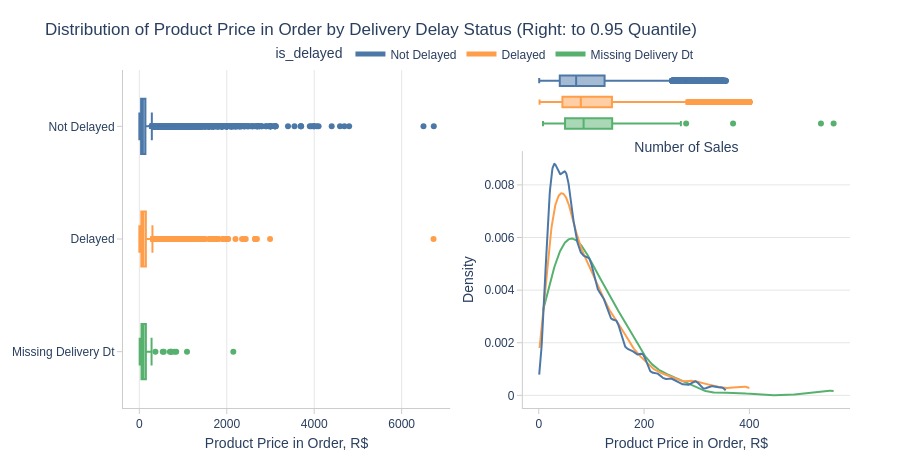
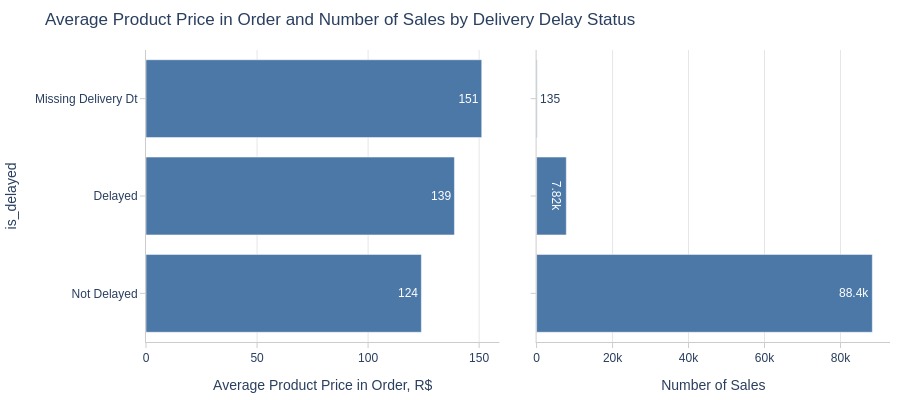
Key Observations:
Delayed orders have higher product prices
By Presence of Installment Payments
pb.histogram(
color='order_has_installment'
, upper_quantile=0.95
, mode='dual_box_trim'
, show_box=True
, show_hist=False
, show_kde=True
).show()
pb.bar_groupby(
y='order_has_installment'
, show_count=True
, to_slide=True
).show()
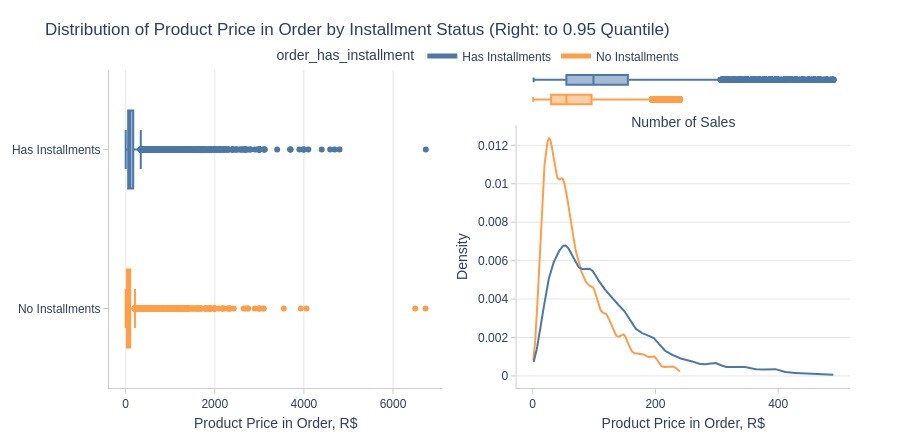
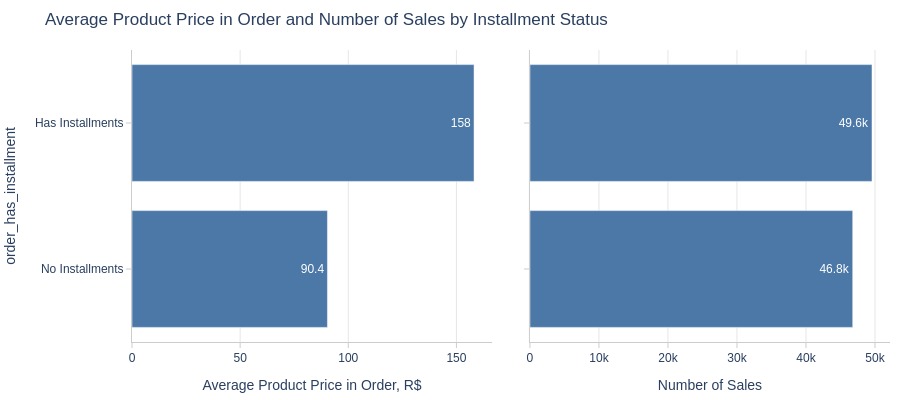
Key Observations:
Installment orders have significantly higher product prices
By Top Customer States
pb.box(
y='customer_state'
, upper_quantile=0.95
, show_dual=True
).show()
pb.bar_groupby(
y='customer_state'
, show_count=True
).show()

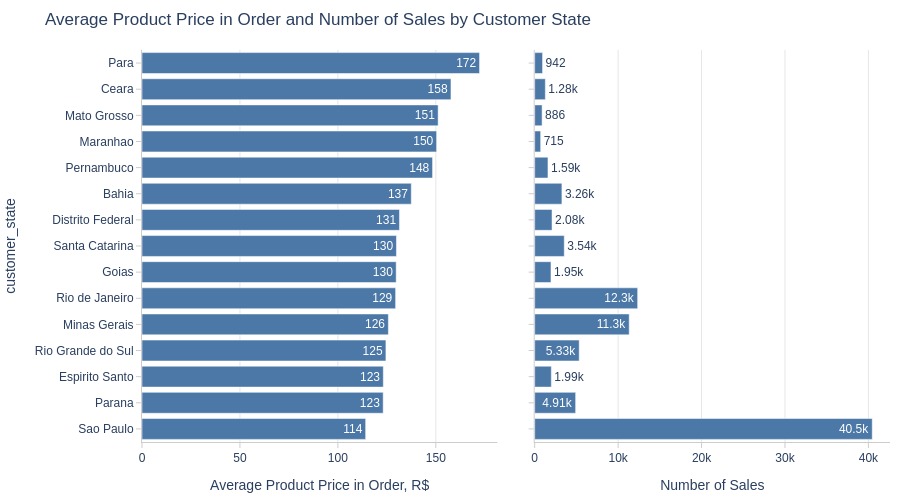
Key Observations:
Para has highest average product price among top states
São Paulo has lowest
By Top Customer Cities
pb.box(
y='customer_city'
, upper_quantile=0.95
, show_dual=True
).show()
pb.bar_groupby(
y='customer_city'
, show_count=True
).show()

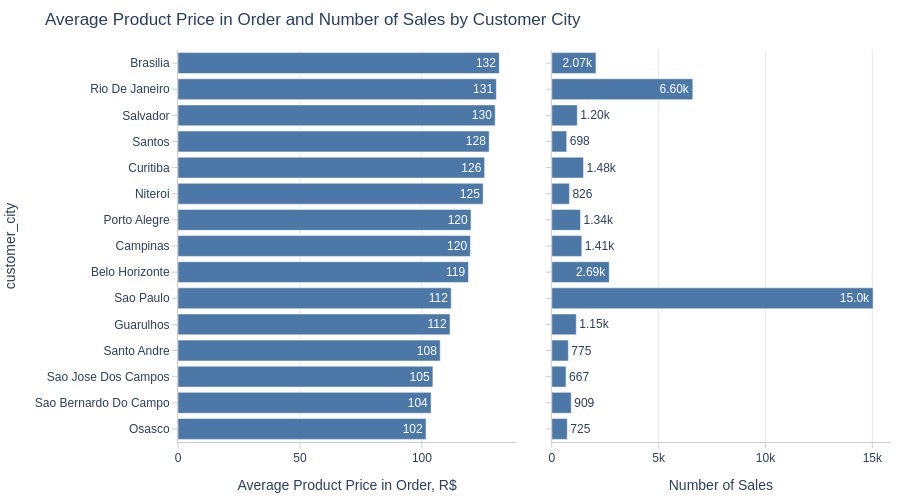
Key Observations:
Brasília, Rio de Janeiro and Salvador have highest product prices among top cities.
Number of Sellers per Order#
pb.configure(
df = df_sales
, metric = 'sellers_cnt'
, metric_label = 'Average Number of Sellers in Order'
, agg_func = 'mean'
, axis_sort_order='descending'
)
Top Orders
pb.metric_top()
| sellers_cnt | |
|---|---|
| order_id | |
| 1c11d0f4353b31ac3417fbfa5f0f2a8a | 5.00 |
| cf5c8d9f52807cb2d2f0a0ff54c478da | 5.00 |
| 91be51c856a90d7efe86cf9d082d6ae3 | 4.00 |
| 8c2b13adf3f377c8f2b06b04321b0925 | 4.00 |
| 1d23106803c48c391366ff224513fb7f | 4.00 |
| 338ffe54b65a3b8124c81ebe6d1cc4b0 | 3.00 |
| a8c403407745aac434946d5058faa6a6 | 3.00 |
| ffb8f7de8940249a3221252818937ecb | 3.00 |
| 30bdf3d824d824610a49887486debcaf | 3.00 |
| 3040863957c9336e7389512584639bb5 | 3.00 |
Let’s see at statistics and distribution of the metric.
pb.metric_info(
labels=dict(sellers_cnt='Number of Sellers in Order')
, title='Distribution of Number of Sellers in Order'
, xaxis_type='category'
)
| Summary | Percentiles | Detailed Stats | Value Counts | |||||||
|---|---|---|---|---|---|---|---|---|---|---|
| Total | 96.35k (100%) | Max | 5 | Mean | 1.01 | 1 | 95.07k (99%) | |||
| Missing | --- | 99% | 2 | Trimmed Mean (10%) | 1 | 2 | 1.21k (1%) | |||
| Distinct | 5 (<1%) | 95% | 1 | Mode | 1 | 3 | 54 (<1%) | |||
| Non-Duplicate | 0 (<1%) | 75% | 1 | Range | 4 | 4 | 3 (<1%) | |||
| Duplicates | 96.34k (99%) | 50% | 1 | IQR | 0 | 5 | 2 (<1%) | |||
| Dup. Values | 5 (<1%) | 25% | 1 | Std | 0.12 | |||||
| Zeros | --- | 5% | 1 | MAD | 0 | |||||
| Negative | --- | 1% | 1 | Kurt | 118.85 | |||||
| Memory Usage | 1 | Min | 1 | Skew | 9.88 | |||||
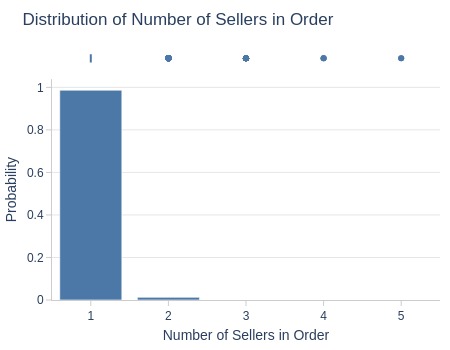
Key Observations:
99% of orders have single seller
Number of Categories per Order#
pb.configure(
df = df_sales
, metric = 'product_categories_cnt'
, metric_label = 'Average Number of Categories in Order'
, agg_func = 'mean'
, axis_sort_order='descending'
)
Top Orders
pb.metric_top()
| product_categories_cnt | |
|---|---|
| order_id | |
| 8c2b13adf3f377c8f2b06b04321b0925 | 3.00 |
| e8c92cfd87f5f0c6d2fc5bc1df5f02b4 | 3.00 |
| 1fcbc88015c88c1a14d4b8ec35ea8ed7 | 3.00 |
| 91be51c856a90d7efe86cf9d082d6ae3 | 3.00 |
| 4ca4a1922b582950b25cce6e7ef34315 | 3.00 |
| 2f8f31eb2f7b6572836d662a6625c8e4 | 3.00 |
| ceb35b18f6b84c1c75f02859ce3160d9 | 3.00 |
| cbb7694680a105281d391bf7002c0477 | 3.00 |
| 6616fa4c89b8bf2a7e17271cdc542fca | 3.00 |
| d4bec1a24c97bd17be18d77297a0f6a0 | 3.00 |
Let’s see at statistics and distribution of the metric.
pb.metric_info(
labels=dict(product_categories_cnt='Number of Categories in Order')
, title='Distribution of Number of Categories in Order'
, xaxis_type='category'
)
| Summary | Percentiles | Detailed Stats | Value Counts | |||||||
|---|---|---|---|---|---|---|---|---|---|---|
| Total | 96.35k (100%) | Max | 3 | Mean | 1.01 | 1 | 95.57k (99%) | |||
| Missing | --- | 99% | 1 | Trimmed Mean (10%) | 1 | 2 | 760 (<1%) | |||
| Distinct | 3 (<1%) | 95% | 1 | Mode | 1 | 3 | 18 (<1%) | |||
| Non-Duplicate | 0 (<1%) | 75% | 1 | Range | 2 | |||||
| Duplicates | 96.34k (99%) | 50% | 1 | IQR | 0 | |||||
| Dup. Values | 3 (<1%) | 25% | 1 | Std | 0.09 | |||||
| Zeros | --- | 5% | 1 | MAD | 0 | |||||
| Negative | --- | 1% | 1 | Kurt | 141.03 | |||||
| Memory Usage | 1 | Min | 1 | Skew | 11.56 | |||||
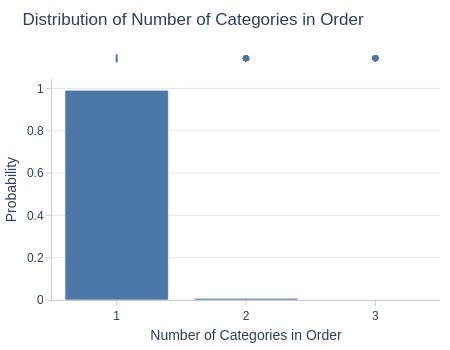
Key Observations:
99% of orders have single category
